FREE
RESOURCES: Classroom
Activities [
Page 7 ]
Student
discussions, exercises, games before and after the play
<
Prev | 1
| 2
| 3
| 4
| 5
| 6
| 7
| 8
| 9
| Next >

This page (Page
#7) has creative activities for use in the classroom. Kids love
to learn more about the play’s origin and subject. Check
out these articles and activities related to ArtReach’s popular titles: Winnie-the-Pooh,
Alice
in Wonderland, Kid Frankenstein,
Robin
Hood, Treasure Island, Pinocchio,
Aladdin, Jack and the Beanstalk,
Little Mermaid, A
Thousand Cranes, Beauty
and the Beast, Sleepy Hollow, Emperor's
New Clothes, Amelia Earhart. Don’t
forget, a Teachers Guide will come with your School Play Package and
contains tons of creative new ideas for your teaching lessons!

Winnie-the-Pooh
Quotes by A. A. Milne
Sweets
thoughts to brighten your classroom.
Use
these quote to spark classroom Discussion.
"Funny,
witty and sometimes bittersweet quotes."
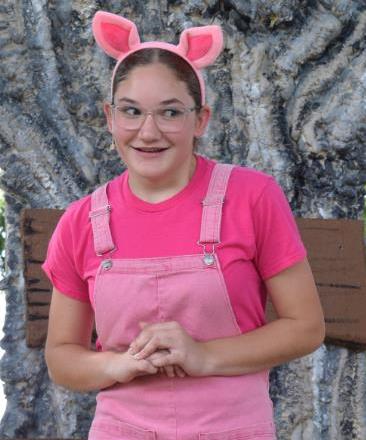 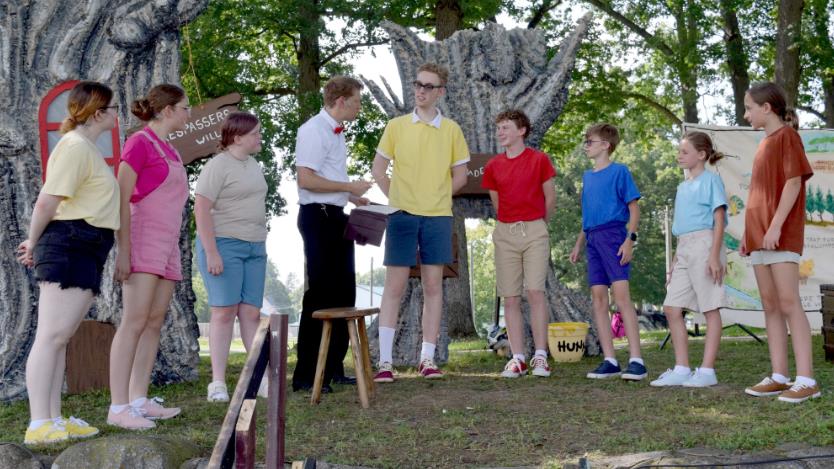
ArtReach's Winnie-the-Pooh
- The Sauk Community Theatre, Jonesville, MI
The
beloved "silly old bear" Winnie the Pooh has delighted
children for generations-but even adults can appreciate the best of
his funny, witty and sometimes bittersweet quotes about life, love,
friendship, growing up-and of course, honey. Truly, everyone loves
great Winnie the Pooh quotes.
Created
by British author A.A. Milne in the 1920s, Winnie the Pooh (then
spelled with hyphens, Winnie-the-Pooh) was an instant success. Milne
based the characters on his son, Christopher Robin, his stuffed
animals-Winnie the Pooh and friends Piglet, Eeyore, Kanga, Roo and
Tigger-and their country home in England's Ashdown Forest.
Disney
bought the rights to Winnie the Pooh in 1961, introducing even more
children to the cheerful bear and his love of the simple joys of
life. Here, warm your heart with some of the Hundred Acre Woods
gang's best quotes from the Winnie the Pooh books.
"A
hug is always the right size." -Winnie the Pooh
"People
say nothing is impossible."
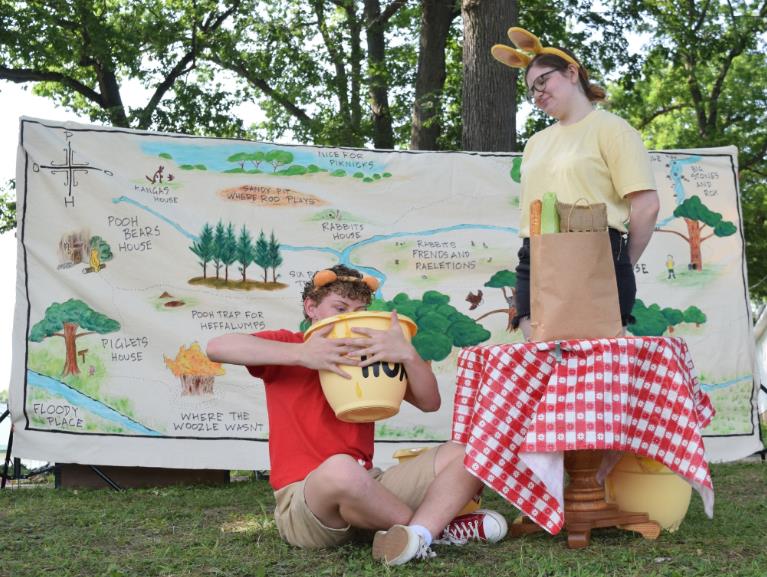 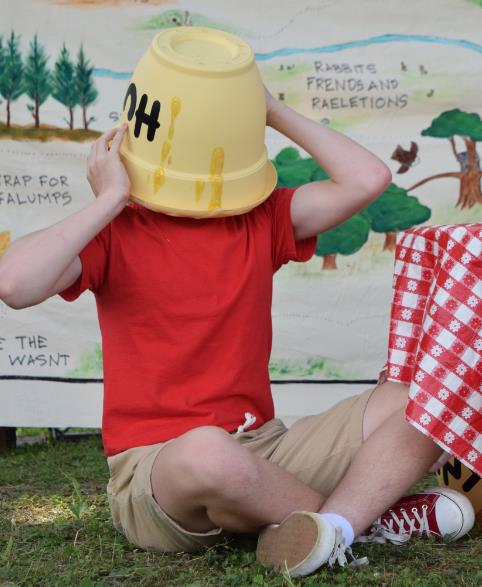
ArtReach's Winnie-the-Pooh
- The Sauk Community Theatre, Jonesville, MI
"The
things that make me different are the things that make me,
me." -Piglet
"You're
braver than you believe, stronger than you seem and smarter than you
think." -Christopher Robin
"Sometimes
the smallest things take up the most room in your
heart." -Winnie the Pooh
"If
you live to be a hundred, I hope I live to be a hundred minus one
day, so that I never have to live a day without you."
-Winnie the Pooh
"A
little consideration, a little thought for others, makes all the
difference." -Eeyore
"People
say nothing is impossible, but I do nothing every
day." -Winnie the Pooh
"A
day without a friend is like a pot without a single drop of honey
left inside." -Winnie the Pooh
"Keep
looking for sunshine."
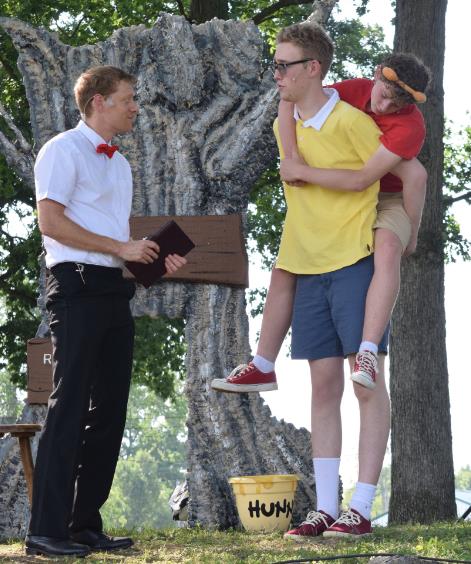 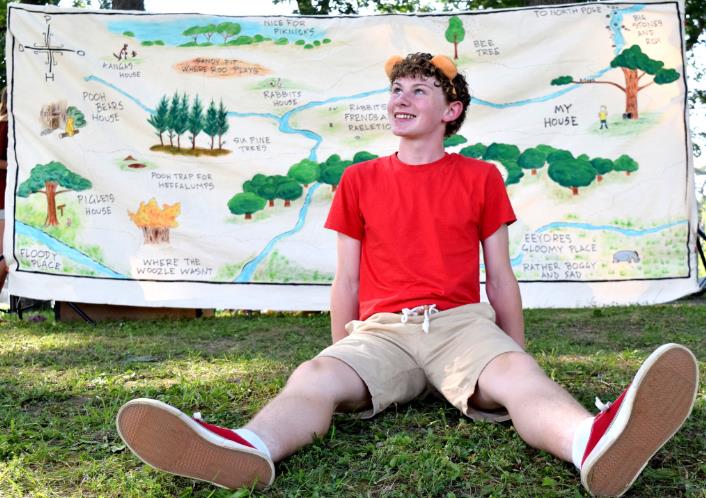
ArtReach's Winnie-the-Pooh
- The Sauk Community Theatre, Jonesville, MI
"It
is more fun to talk with someone who doesn't use long, difficult
words but rather short, easy words like, 'What about
lunch?'" -Winnie the Pooh
"If
the person you are talking to doesn't appear to be listening, be
patient. It may simply be that he has a small piece of fluff in his
ear." -Winnie the Pooh
"Some
people care too much. I think it's called love."
-Winnie the Pooh
"It
never hurts to keep looking for sunshine." -Eeyore
"Those
who are clever, who have a Brain, never understand
anything." -Winnie the Pooh
"They're
funny things, Accidents. You never have them till you're having
them." -Eeyore
"If
people are upset because you've forgotten something, console them by
letting them know you didn't forget-you just weren't
remembering." -Winnie the Pooh

Fun
Facts About Alice in Wonderland and Lewis Carroll
Who knew?
Fun Stuff for Classroom Learning!
Alice's
character was based on a real-life little girl named Alice Liddell.
She was in fact not a blonde as illustrated in the book but a
brunette. The real life Alice has been portrayed in fiction almost as
many times than the fictional one!
The
real Alice, who lent her name to the story, was the daughter of
Henry Liddell, the dean of Christ Church College at Oxford, where
Carroll taught mathematics. "Everyone who was employed by the
school lived on campus," says Carolyn Vega, the assistant
curator of literary and historical manuscripts at the Morgan Library,
which is currently running an exhibition on Alice. "Carroll met
the dean and Alice's older brother first, and that's how he came to
know the entire family."
"Based
on a real-life little girl named Alice Liddell."
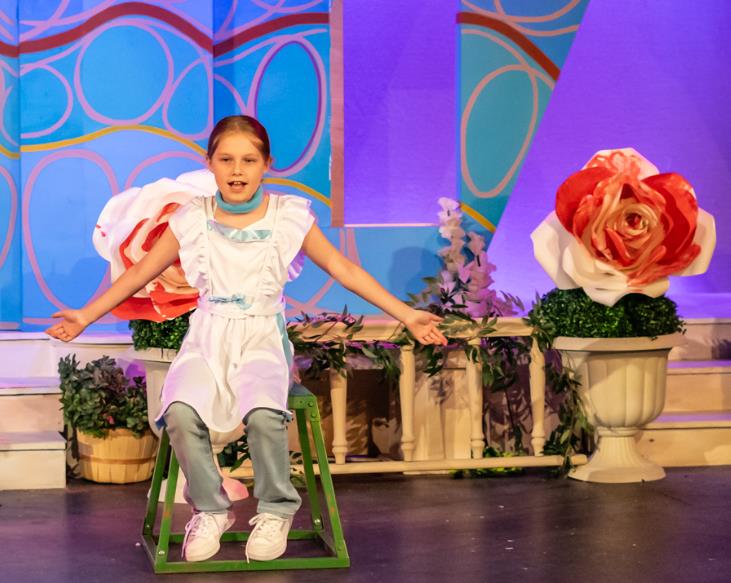 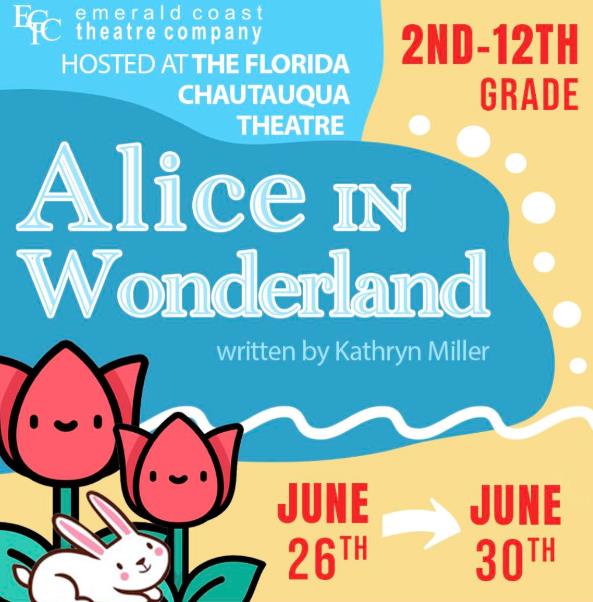
ArtReach's Alice
in Wonderland - Emerald Coast Theatre
Company, Miramar Beach FL
The
names of the three little sisters in the Dormouse's story (Elsie,
Lacie and Tillie) also refer to the names of the three Liddell
sisters. Elsie originated from the initials of Lorina Charlotte,
Lacie is a transformation of Alice, and Tillie was short for Matilda,
a name given to Edith by her sisters.
Lewis
Carroll suffered from a rare neurological disorder that causes
strange hallucinations and affects the size of visual objects, which
can make the sufferer feel bigger or smaller than they are - a huge
theme of the book. The disease, first discovered by English
psychiatrist John Todd in 1955, was later named Alice in Wonderland
Syndrome. It is also known as Todd's syndrome.
"The
disease was later named Alice in Wonderland Syndrome."
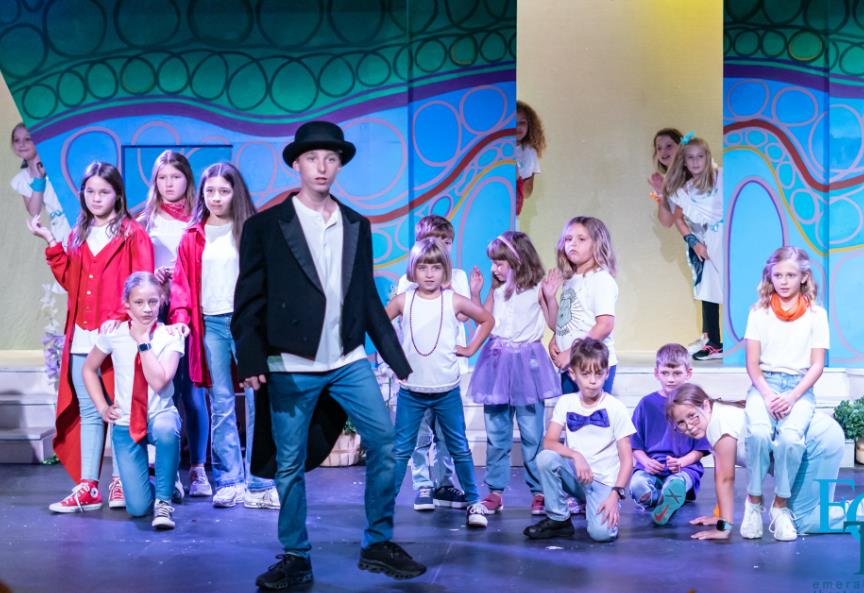 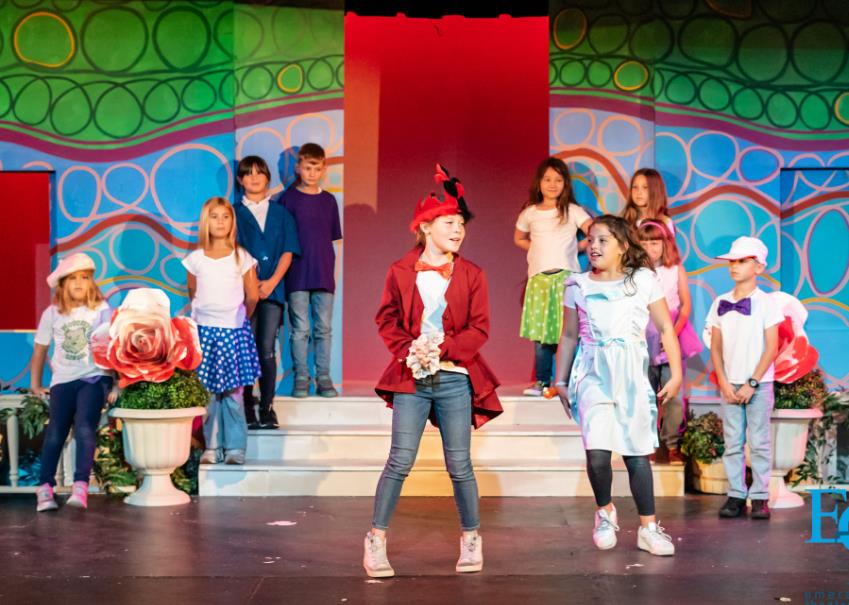
ArtReach's Alice
in Wonderland - Emerald Coast Theatre
Company, Miramar Beach FL
Lewis
Carroll's real name was Charles Lutwidge Dodgson. His pseudonym is
an Anglicization of Ludovicus, the Latin version of
"Lutwidge", and the Irish surname Carroll, which bears
great resemblance to the Latin forbear of "Charles", Carolus.
In
1890 Lewis Carroll released a shortened version of Alice's
Adventures in Wonderland for smaller children aged "from nought
to five". It includes 20 of John Tenniel's illustrations from
the original book colored, enlarged and, in some cases, revised.
"Cheshire
Cat was named after Dodgson's birthplace, Cheshire."
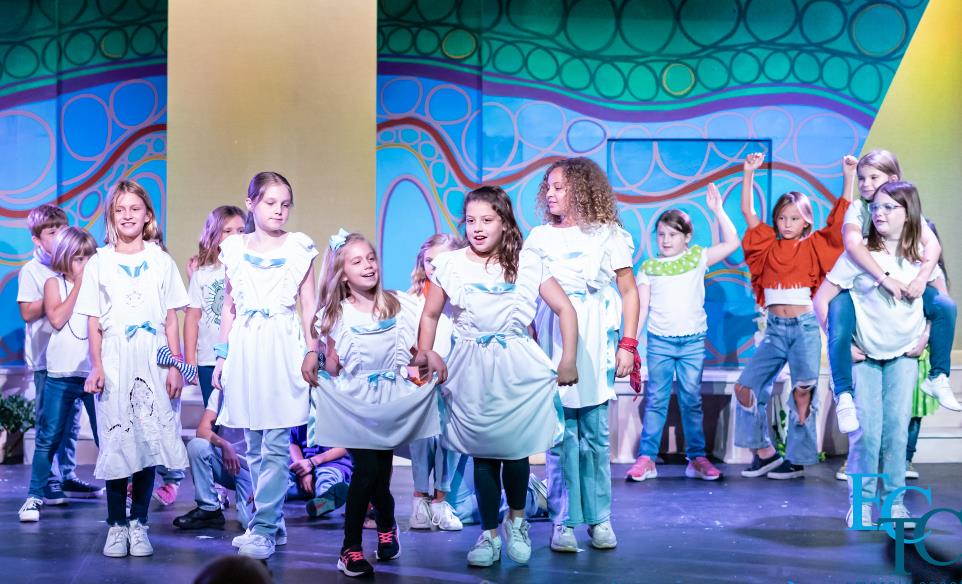 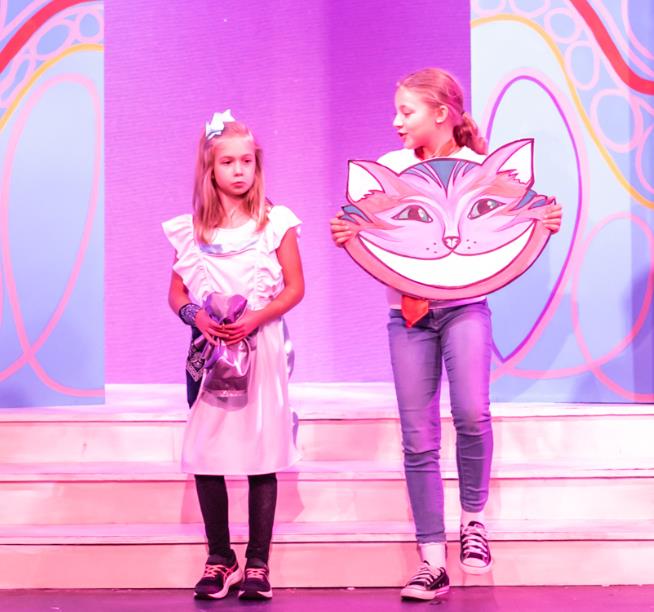
ArtReach's Alice
in Wonderland - Emerald Coast Theatre
Company, Miramar Beach FL
The
novels were banned in China in 1931, on the grounds that
"animals should not use human language"
The
Cheshire Cat was named after Dodgson's birthplace, Daresbusy,
Cheshire, England. An area with an abundance of dairy farms, the
popular phrase "grinning like a Cheshire cat" referred to
how happy a cat might be living in such close proximity to all that
milk and cream. Other sources say they made cheese molds shaped like
a grinning cat and would cut cheese from the tail first, leaving the
grin to be the last thing to disappear.

Frankenstein
in Popular Culture, Before
ArtReach's "Kid Frankenstein"
Classroom Discussion
Mary
Shelley's novel Frankenstein, and the famous character of
Frankenstein's monster, have influenced popular culture for almost
two centuries. The work has inspired numerous films, television
programs, video games and derivative works. The character of the
monster remains one of the most recognized icons in horror fiction
and is one of the most popular Halloween costumes for kids and adults alike.
"Why
does the monster remain so
famous?"
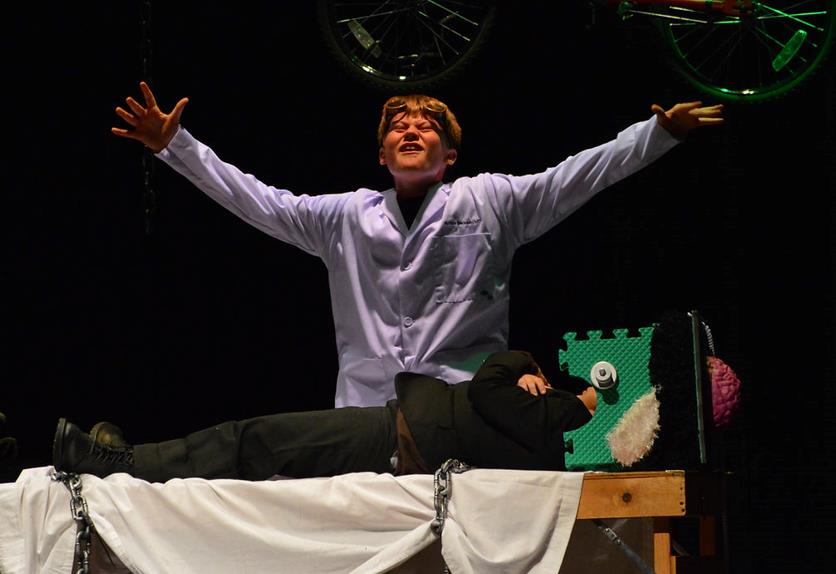 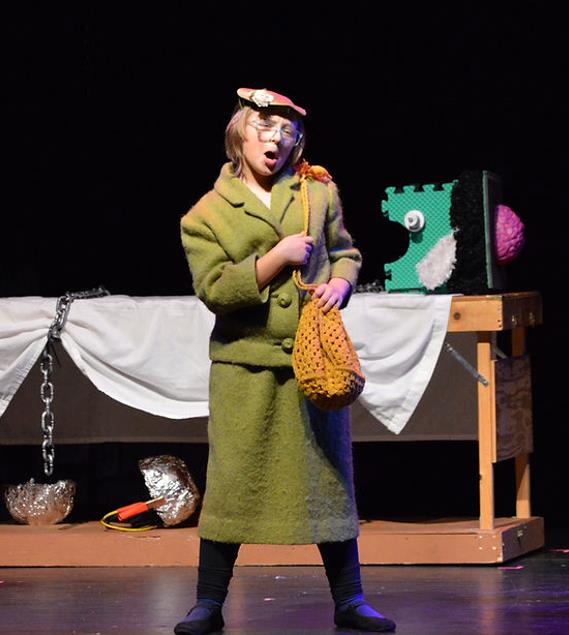
ArtReach's Kid
Frankenstein - A Children's Theatre of Mesilla, Las Cruces, NM
Silent
Era - The
first film adaptation of the tale was made by Edison Studios in 1910.
The brief (16 min.) story has Frankenstein chemically create his
creature in a vat. The monster haunts the scientist until
Frankenstein's wedding night, when true love causes the creature to
vanish. For many years, this film was believed lost. A collector
announced in 1980 that he had acquired a print in the 1950s and had
been unaware of its rarity.
The
Edison version was followed by another adaptation entitled Life
Without Soul (1915) about a modern-day Frankenstein who creates a
soulless man. In the end, it turns out that a young man has dreamed
the events of the film after falling asleep reading Mary Shelley's
novel. This film is now considered a lost film.
"Universal
Pictures starred Boris Karloff as the monster."
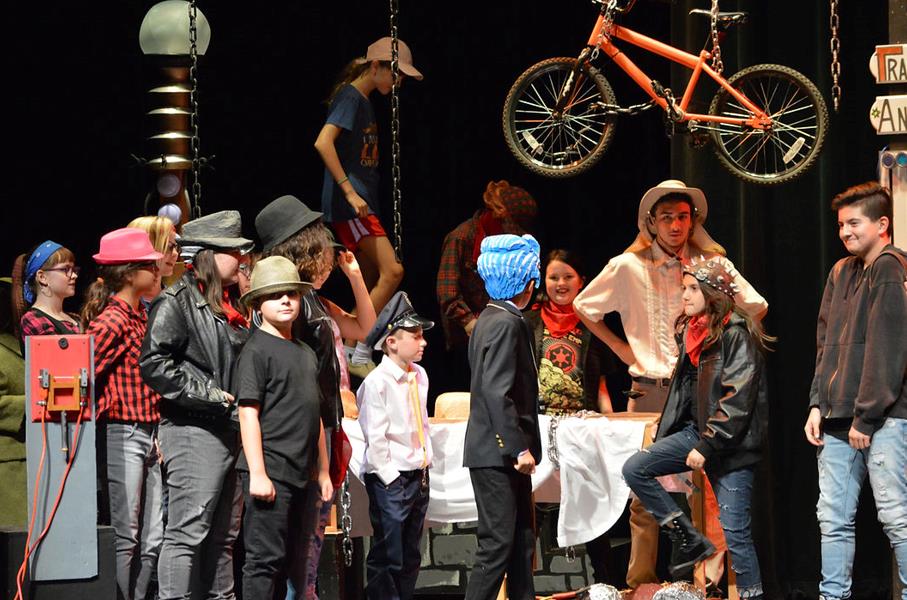 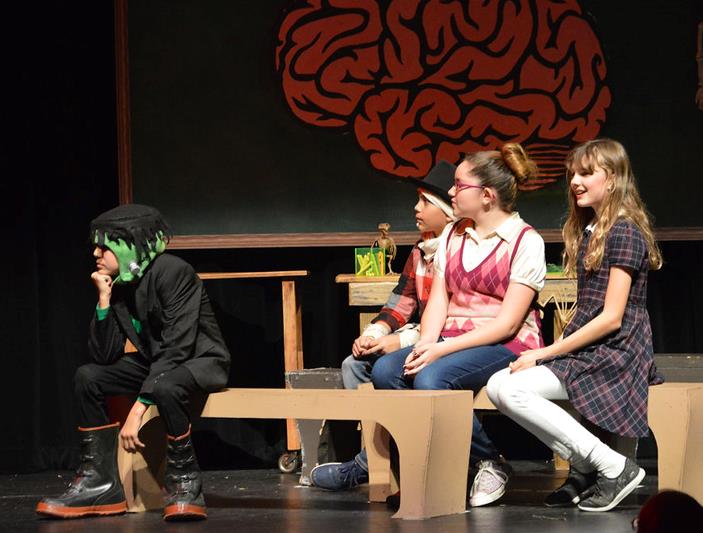
ArtReach's Kid
Frankenstein - A Children's Theatreof Mesilla, Las Cruces, NM
There
was also at least one European film version, the Italian Il Mostro
di Frankenstein (1921). The film is also now considered lost.
Universal
Pictures -
The first and by far the most iconic sound adaptation, Frankenstein
(1931), was produced by Universal Pictures starring Boris Karloff as
the monster. It has been preserved in the United States National Film
Registry. Its sequel, The Bride of Frankenstein (1935) also starred
Karloff. It was followed by Son of Frankenstein (1939), the last one
with Karloff. The Ghost of Frankenstein (1942) was considered a B
movie. Others were: Frankenstein Meets the Wolf Man (1943); House of
Frankenstein (1944); House of Dracula (1945); and the comedy Abbott
and Costello Meet Frankenstein (1948).
"There
have been hundreds of works created from the Frankenstein story."
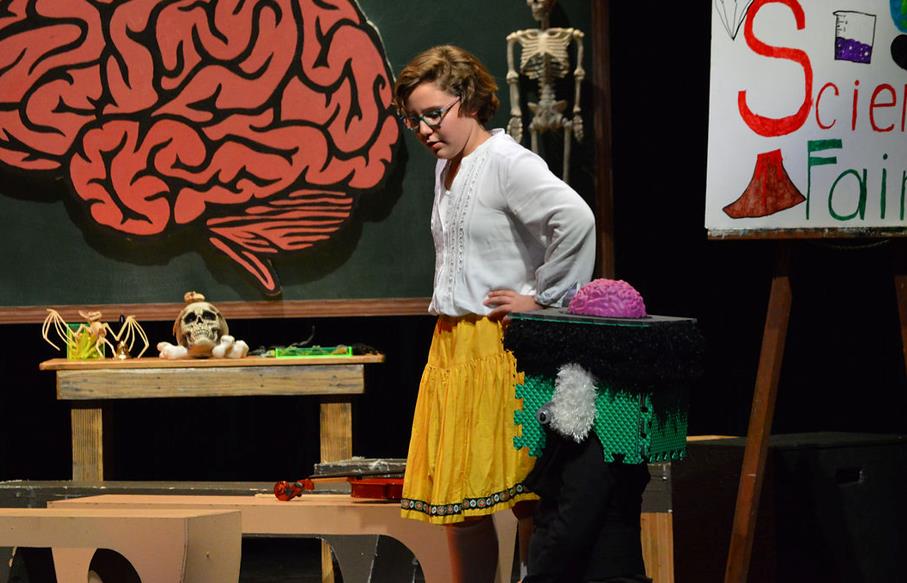 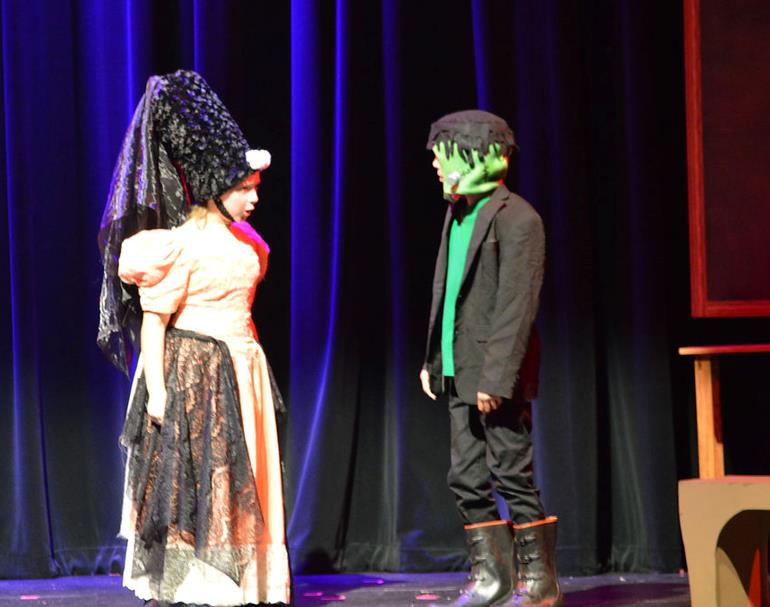
ArtReach's Kid
Frankenstein - A Children's Theatre of Mesilla, Las Cruces, NM
Though
the story had existed for over 100 years, it was the success of the
Universal films that established Frankenstein as an iconic part of
popular culture - identified more with the Creature than with Dr.
Frankenstein. Since then, there have been hundreds of works (films,
TV series, cartoons, books, stage plays, toys, costumes, etc.)
created from or influenced by the Frankenstein story. For an in-depth
account of these numerous works, see Wikipedia's page
"Frankenstein in Popular Culture."
"Imagination
will often carry us to worlds that never were,
but
without it we go nowhere."
Carl
Sagan
ArtReach's
Robin Hood: Was He a Real
Person or Just a Myth?
Discussion of
Middle Ages Hero or Outlaw for Classroom
One of the romantic heroes of
the Middle Ages was the outlaw Robin Hood of England. Whether he was
a living man or only a legend is uncertain. Old ballads relate that
Robin Hood and his followers roamed the green depths of Sherwood
Forest, near Nottingham, in the center of England. There they lived a
carefree life, passing the time playing games of archery, hunting the
king's deer, and robbing the rich. They shared their spoils with the
poor and never injured women or children.
Robin Hood probably became an
outlaw by killing a deer on a wager. Then he had slain one of the
king's foresters who threatened his life. A price was set on Robin's
head, and he went into hiding.
"A
price was set on Robin's head and he went into hiding."
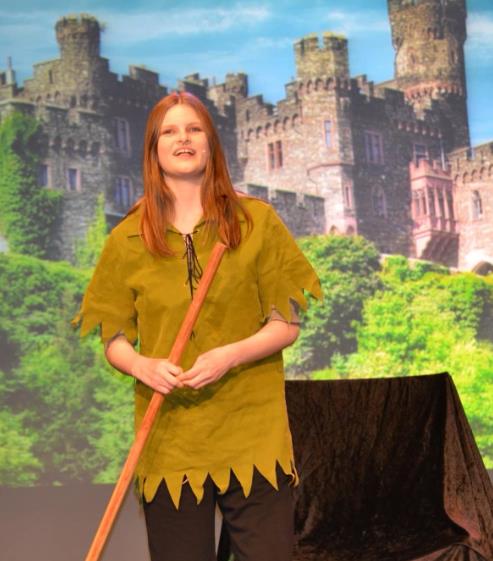 
ArtReach's Robin
Hood, Boserup School, Roskilde, Denmark
Soon there gathered about him
other bold men who had been outlawed or deprived of their
inheritances. Some of them hated the hard rule of the barons. Others
loved the free life of the outdoors. More than once a man won an
honored place in the band by defeating Robin Hood himself in a fair fight.
One day, when Robin was about
to cross a narrow bridge, a stranger seven feet tall blocked the way.
The two men fought with quarterstaves (long, stout sticks), and Robin
Hood was knocked into the stream. As soon as he could scramble out of
the water and catch his breath, Robin Hood praised this stranger and
asked him to join his band. Thus Little John, so called because of
his great size, became Robin Hood's right-hand man.
"Robin
Hood praised Little John and asked him to join his band."
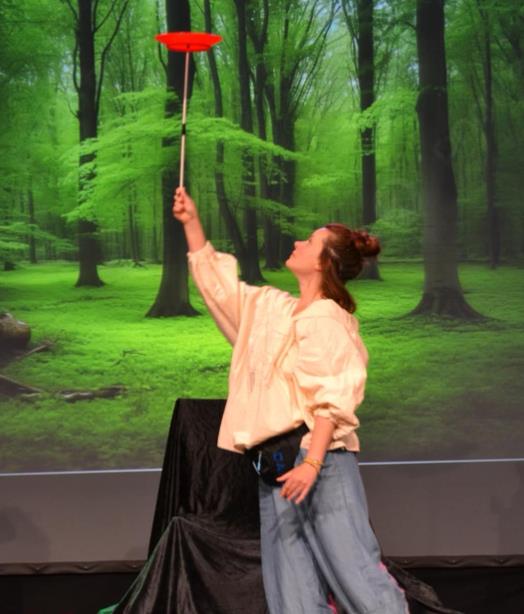 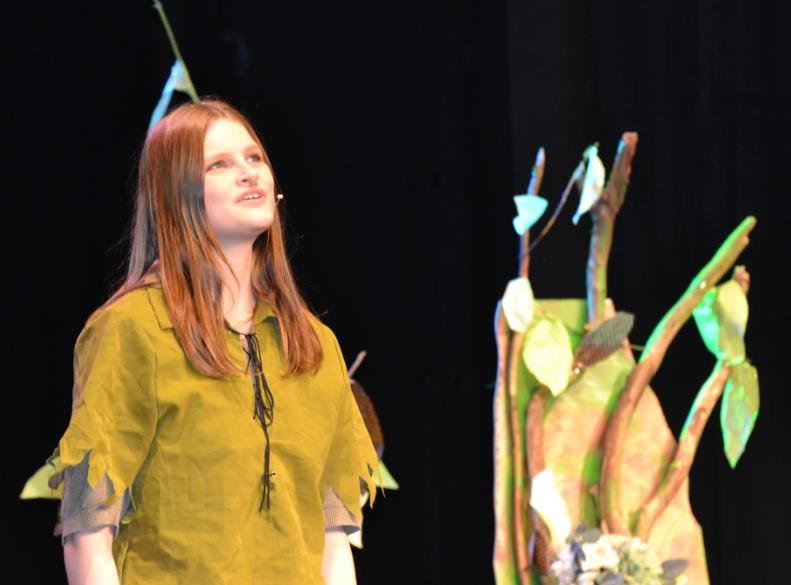 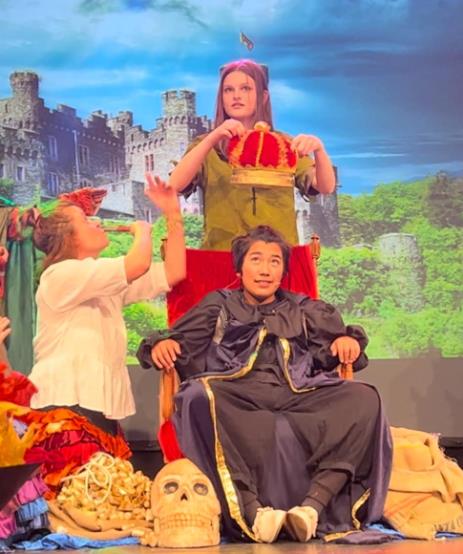
ArtReach's Robin
Hood, Boserup School, Roskilde, Denmark
Will Scarlet and
Arthur-a-Bland, a tanner, also fought their way into the band. Others
whose names often occur in the ballads are Will Stutely, Midge, a
miller's son; and the romantic minstrel Alan-a-Dale. Robin Hood's
chaplain and confessor was the fat and jovial Friar Tuck.
In later ballads Robin's
sweetheart, Maid Marian, was introduced. When Robin Hood was
outlawed, she dressed as a page and went to seek him in Sherwood
Forest. At last they met. Both were disguised, and neither recognized
the other. They fought until Robin, admiring her skill, invited
Marian to join his band. Then she recognized his voice.
"Robin
Hood's greatest enemy was the sheriff of Nottingham."
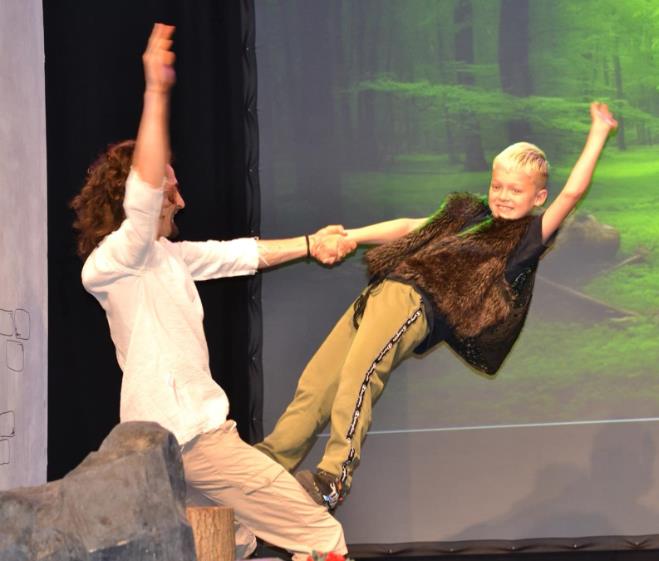 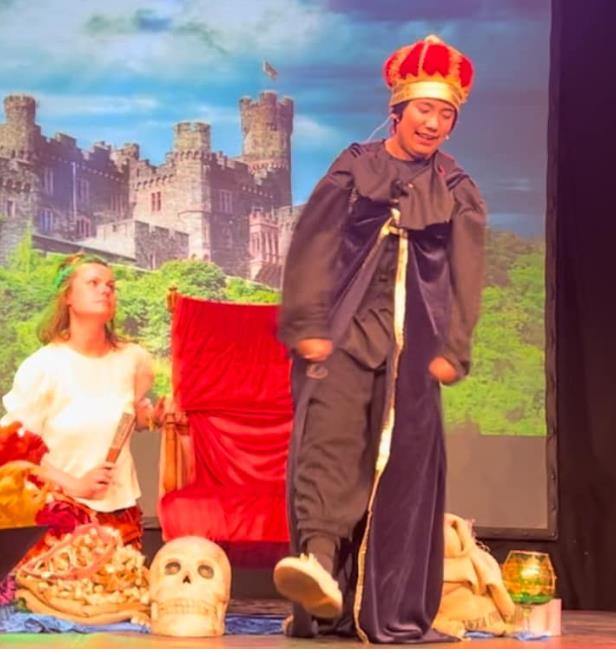
ArtReach's Robin
Hood, Boserup School, Roskilde, Denmark
Robin Hood's greatest enemy
was the sheriff of Nottingham. The sheriff tried by force and
trickery to bring the outlaw to justice. He was always outwitted. He
even announced a shooting match, feeling sure that Robin Hood would
appear to show his skill as an archer. The outlaw did appear, but in
disguise. He won the prize, a golden arrow, which was handed to him
by the sheriff himself. Not until Robin was once more safe in
Sherwood Forest did the sheriff learn how he had been deceived.
Although Robin Hood lived on
the king's deer, the ballads say that the outlaw "loved no man
in the world so much as his king." According to one tale King
Richard the Lion-Hearted went in disguise to Sherwood Forest and,
having tested Robin Hood's loyalty, granted him a royal pardon.
"Such
outlaws as he and his men will England never see again."
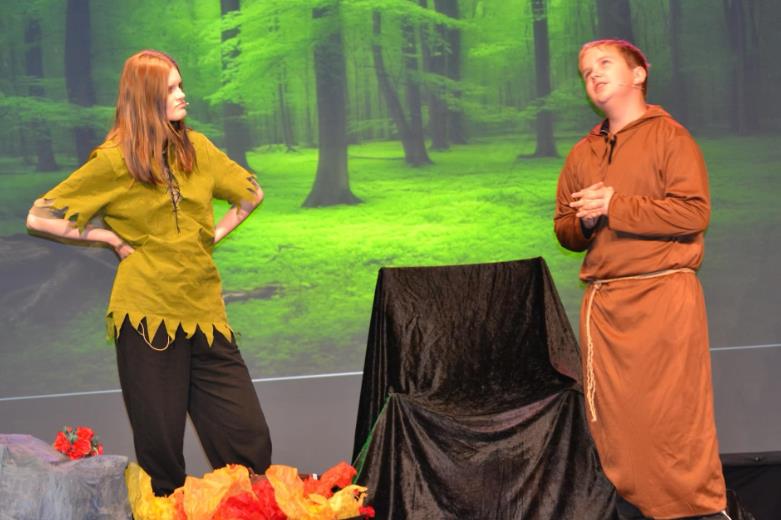 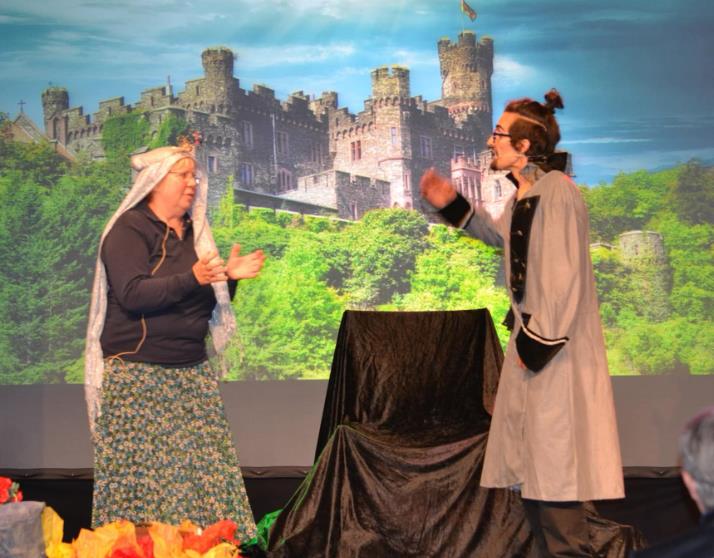
ArtReach's Robin
Hood, Boserup School, Roskilde, Denmark
The Robin Hood legends may
have grown up about some actual victim of the harsh forest laws of
old England. Robin Hood is said to have lived from 1160 to 1247. Some
accounts state that he was created earl of Huntingdon by Richard the
Lion-Hearted. Most of the legends say that Robin Hood died at
Kirklees Priory, in Yorkshire. Near the ruins of this priory is a
grave supposed to be Robin's. The epitaph (with the spelling
modernized) reads:
Here underneath
this little stone
Lies Robert,
Earl of Huntingdon.
Ne'er archer
was as he so good
And people
called him Robin Hood.
Such outlaws as
he and his men
Will England
never see again.
Who
Was Robert Louis Stevenson?
Study guide
Information for ArtReach's Treasure
Island
Robert Louis Stevenson wrote
novels, plays, poetry and more, but he's best known for two novels
that have since become classics.
Treasure
Island: 'Treasure Island' was first written as a serial,
published one chapter at a time in the magazine 'Young Folks' from
October 1881 to January 1882. During this time, the story was
called 'The Sea Cook'. In 1883, 'Treasure Island' was published as a novel.
"Jim
Hawkins, who goes on an adventure to find hidden treasure."
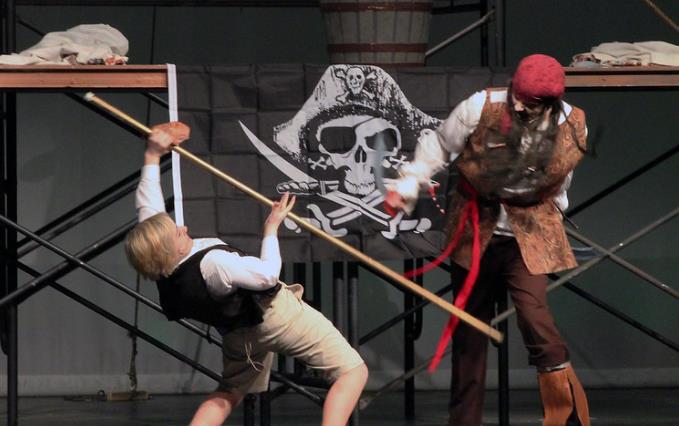 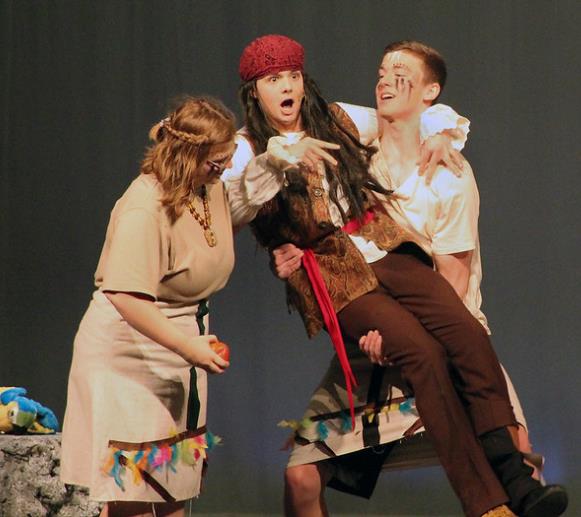
William Floyd
Thespians, Mastic Beach NY
The story follows a young boy,
Jim Hawkins, who goes on an adventure to find hidden treasure after
being gifted a map by a pirate. Throughout the story, he comes up
against mutiny and treachery, as well as sword fights and excitement
as he and his crew learn to navigate the world of piracy.
'Treasure Island' is credited
as being one of the first books that could be seen as romanticizing
the world of pirates. It also introduces a lot of tropes about
pirates that are still used today, such as black-sailed ships and
treasure maps marked with a cross. It's also thought to be one of the
first books aimed at an adolescent audience that isn't obviously
about morality.
"One
of the first books that romanticized the world of pirates."
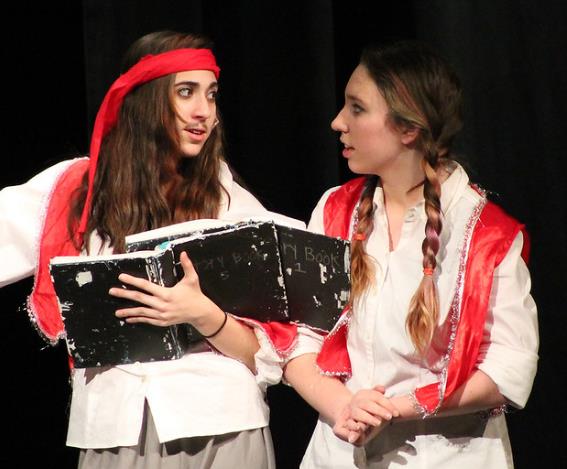 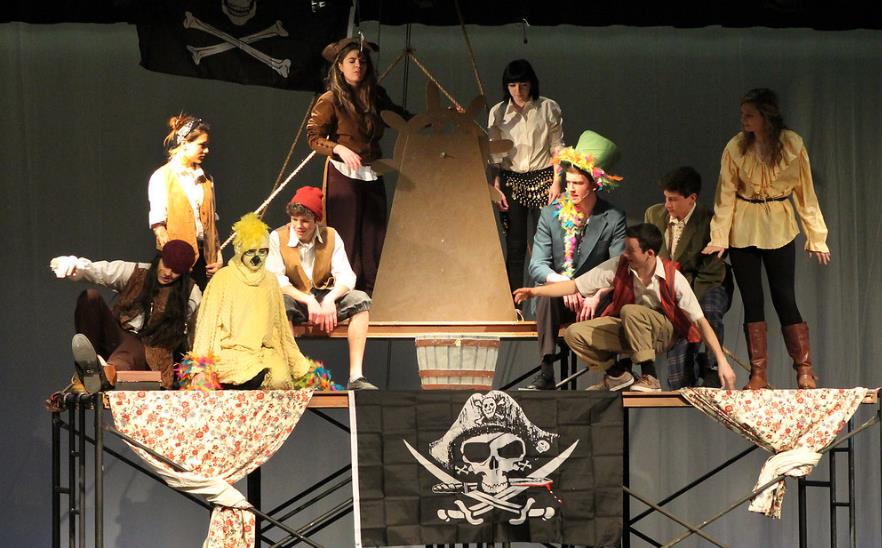
William Floyd
Thespians, Mastic Beach NY
The success of 'Treasure
Island' has endured over the years since it was first published. Over
fifty adaptations have been made of the story, including films, TV
shows, theatre productions, and audio dramas. As well as adaptations,
there have also been numerous sequels and prequels written by other
authors inspired by Stevenson's work.
Strange
Case of Dr Jekyll and Mr Hyde: 'Strange Case of Dr
Jekyll and Mr Hyde' is a Gothic novella published in 1886. A novella
is a term used to describe a story that is shorter than a novel but
longer than a short story.
The story centers around a
man, Dr Jekyll, who has managed to create a drug that splits his good
traits and his evil traits into two separate personalities. Over
time, his evil personality, Mr Hyde, gains more control and power,
ultimately taking over Dr Jekyll and becoming Mr Hyde permanently.
"The
success of 'Treasure Island' has endured over many years."
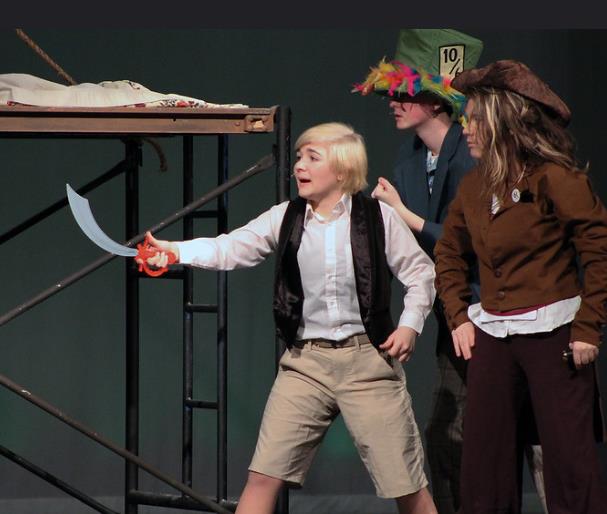 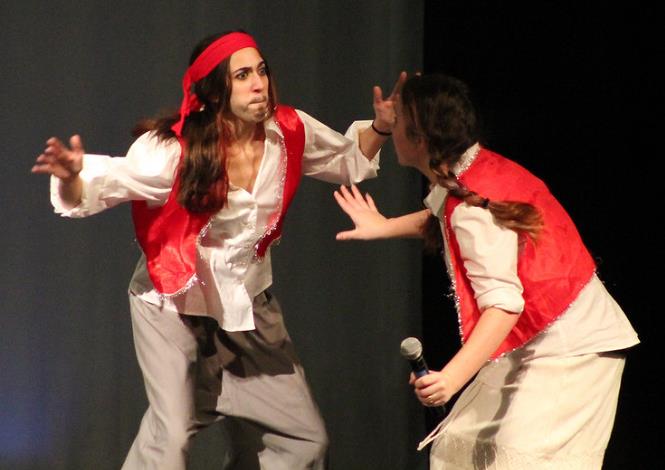
William Floyd
Thespians, Mastic Beach NY
Robert
Louis Stevenson Facts:
A lot of Stevenson's original
manuscripts have been lost. They were sold off by his descendants
around the start of the First World War, which was when his work
stopped being as popular.
At the age of 36, Stevenson
started to learn the piano and began to write his own musical compositions.
There is a museum dedicated to
the life of Robert Louis Stevenson in Samoa.
The idea for 'The Strange Case
of Dr Jekyll and Mr Hyde' came to Stevenson in a dream. Stevenson was
so inspired by his dream that he wrote 40,000 words of the first
draft in three days.
According to a UNESCO index of
translated authors, Stevenson is the twenty-fifth most translated
author in the world.
After the Stevensons got
married, they had their honeymoon next to an abandoned silver mine.
Stevenson's work hasn't always
been as popular as it is now. In fact, it wasn't until the 1950s that
his work gained worldwide acclaim.
The
Pinocchio Game: Kids Become Puppets
A Fun Idea for
Creative Dramatics
This is a
really great way to start a rehearsal on a physical high. It is a
warm-up, stretching exercise with dramatic content to keep it
focused. It is named after the wooden puppet (if you do it at
Christmas, you can call it The Nutcracker Game). The game consists
basically of a narrative pantomime of the wooden puppet SLOWLY coming
to life. Here are some things you can say to play the game:
Right now
you're made completely of wood. Your arms and legs are carved from a
single piece of wood. You can't move any part of yourself at all.
Now a magic
spell has begun. It begins at the top of your head. The spell moves
down slowly until your head down to your eyebrows is flesh and blood.
Try and move your eyebrows.
"A
magic spell has begun."
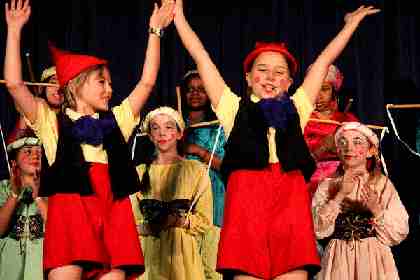 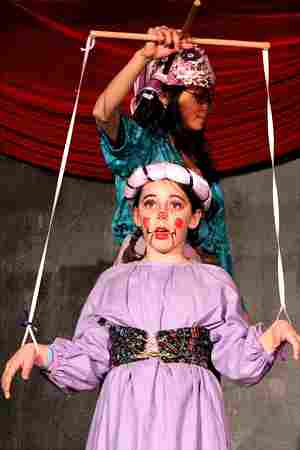
Kenwood School, Minneapolis --
3rd, 4th and 5th Graders.
The spell keeps
moving down. Now you can move your eyes! All your life you've been
staring straight ahead, and now you can look to the sides. The
spell gets to your ears and your nose. See if you can wiggle
them. The spell gets to your mouth. You can smile. It feels
strange at first, and probably looks pretty strange too, but you grow
more comfortable with it. Try some other facial expressions as well.
Slowly you
discover that you can turn your head. Careful! You can look up and
down carefully as well. Look! You have feet! This is the first time
you were ever sure.
The spell
reaches your shoulders. But remember, your arms and hands are still
attached to your body, since you are carved from a single piece of
wood, so you can move ONLY your shoulders. Try some circles. Do you
feel a tingle up and down your spine? That's the magic working.
The spell
reaches your chest. You can puff it out like a soldier. Your elbows
can move now, but still not your hands. As the spell goes lower, see
if you can pull your left hand away from your body. Ooofff! You did it.
"You're
all real now!"
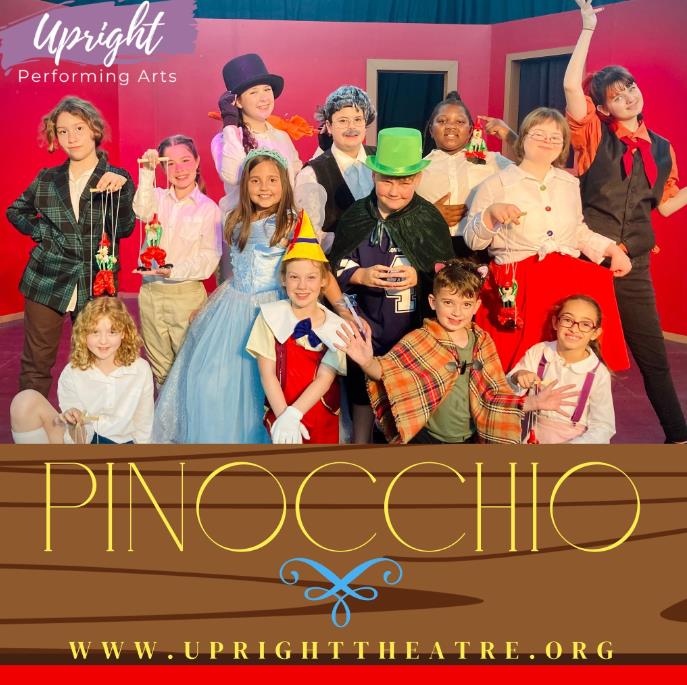 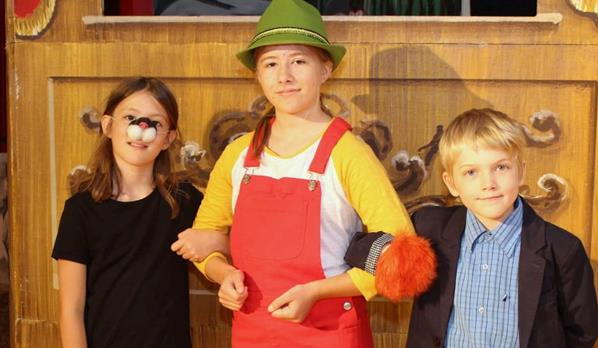
Upright Theatre Company,
Euless TX - YAAN (Young Actors Assoc of Niagara), NY
Bring your hand
up to your face and study it. See if you can move the fingers. Wow!
You've never seen anything so beautiful! See if you can get your
right hand free as well. Does it move too?
The spell has
reached your waist. Carefully bend forward, to the side. See if you
bend backwards. See if you can make a circle. The spell reaches your
hips, but your knees are still locked together and your feet are
still attached to your pedestal. The spell gets to your knees. See if
they bend!
Reach down and
see if you can pull your left foot free. Ooofff! Point the toe. Flex
the foot. Make little circles. Now see if you can get your right foot
free. You're all real now! See how you can move. Careful at first
– these are your first steps! Let's find all the ways our new
bodies move!
And so on&ldots;
ArtReach's
Aladdin: Drama Fun and Activities
Performing Aladdin?
Try these in your classroom first.
MAGIC
CARPET: Have children draw a place on
the floor around their desk. Pretend it is a magic carpet. Tell them
to close their eyes and wait until you count: one, two, three!
Imagine that you are flying on a magic carpet. What do you see
below you? What do you see above you? Where do you want the carpet to
take you?
"Where
will your magic carpet take you?"
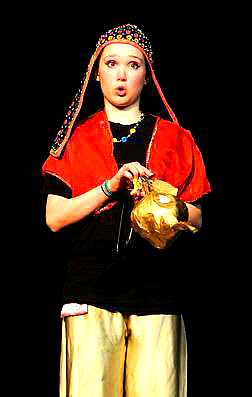 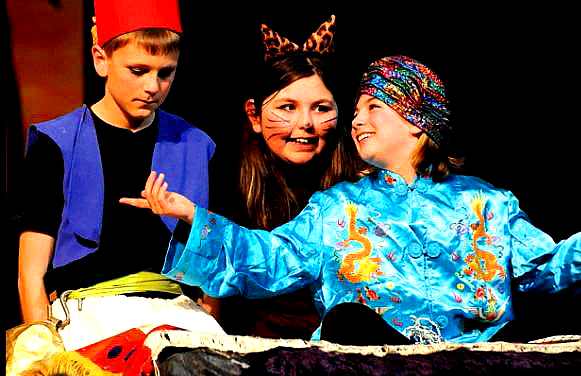
ALADDIN
at Vergennes Union Elem School (VT)
LAMPS:
Discuss the lamp that the Genie lives in. Is it like any lamp you
have seen before? Discuss the difference between it and what you have
seen. Discuss the history of oil lamps. Why are lamps such an
important part of our lives?
GENIE: Pretend
you are a Genie in an oil lamp. How do you like it in there? Do you
have furniture? Do you want to get out? How would you dress if you
were a Genie? Can you think of other magical creatures like Genies?
Are there similar characters in the stories you watch on TV or in the movies?
THREE
WISHES: Teacher, pretend you are Genie
and you have the power to grant each child three wishes. Have them
write down their three wishes. What do you want more than anything in
the world? Sometimes you can wish for a thing like a new car. And
sometimes you can wish for something that is not tangible, the way
the Genie wishes for his freedom. What kind of things like that do
you wish for? Happiness? Love? Now think of others such as friends
and family. What do you wish for them?
THE
CAVE OF WONDERS: Have
some of the children create the cave doors. Others may ask to be let
in the cave by calling out: Open Sesame! The cave may refuse to admit
them but they must explain their reasons. If the children are
admitted what do they find there? Have them pretend they are in a
cave that is dark and echoic. What kind of treasure might they find
there? If you find a statue made of gold have someone show how that
statue would look.
Finding
Treasure: "Open Sesame!"
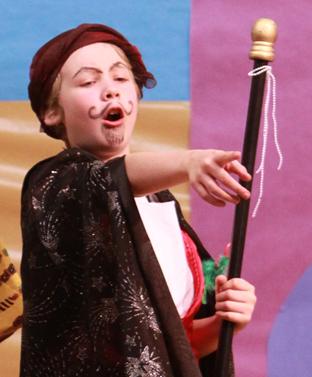 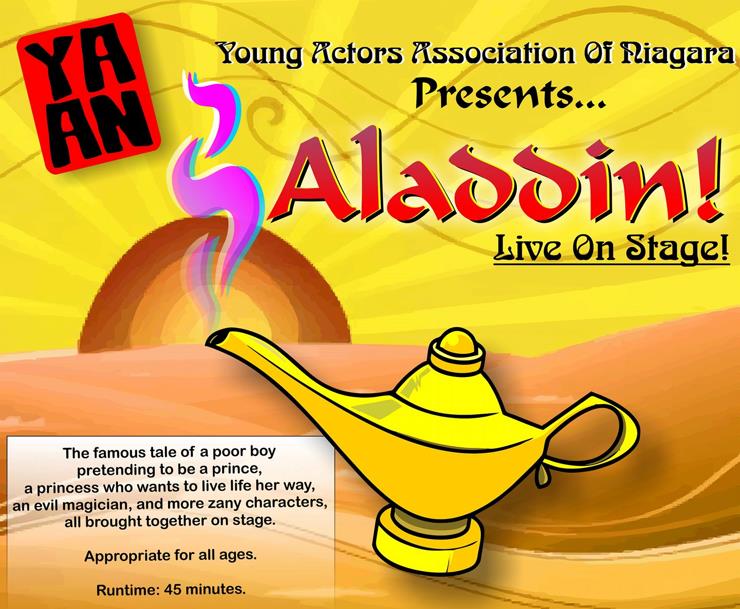
Monkton Central
School, Vermont - YAAN (Young Actors Assoc of Niagara), NY
IMAGINARY
FRIENDS: Have
the children think about what kind of side kick they would like to
have with them all the time, the way Aladdin has his cat Persia. What
kind of animal would you have? If they could talk what would be their
language? Would they help you in times of trouble? If they got in
trouble what would you do for them?
PALACES: Have
the children compare their house to a palace? What would a palace
have that you don’t have at home? What would the palace be made
of? Sugar, chocolate, ice, glass? What would your room in the
palace look like? Would you let other people live there too?
MAGIC
STAFF: Omar the Magician has a magic
staff where he keeps all his magic power. If you had magic power
where would you keep it? In your backpack, in your hat, in your desk?
Name two things that your power lets you do that you cannot do
without it. Would you want to be invisible, to fly, to have new toys?
If you could give one of your powers away who would you give it to?
PRINCES
AND PRINCESSES: Pretend you are a
prince or princess. What clothes would you wear and where would you
live? Would you go to school? Would you have to do homework? If you
were a princess what would be different from the way you are now?
MUSIC: Listen
to Scheherazade by Nikolai Rimsky-Korsakov. Discuss the origins of
the piece and talk about which parts you liked best. Read the story
of Scheherazade and talk about how the music fits the parts of the story.
Listen
to Scheherazade (Vienna Philharmonic)
DIFFERENT
STORIES: The
original story in this Guide is quite different from the story in the
play. Can you identify the different parts? Why do you think the
story is different? If you could change the story what would you put in?
CREATIVE
WRITING: Aladdin is just one of many
stories from The Arabian Nights. Have the children write a
story that is all their own using the same characters: Boy, girl,
magician, sultan, genie – maybe even give them different names.
Discuss what their new story is about. Love, power, freedom, good
over evil? What can the characters do to prove they have these things?
ArtReach's
"Jack and
the Beanstalk" Glossary
Getting Ready
for a Hill Country Adventure!
Old
Timers: Old timers are people who have been around a
long time. In Appalachia music and stories are often called
“old-timey” because they are passed down from generation to generation.
"Appalachia
music & stories are often called old-timey."
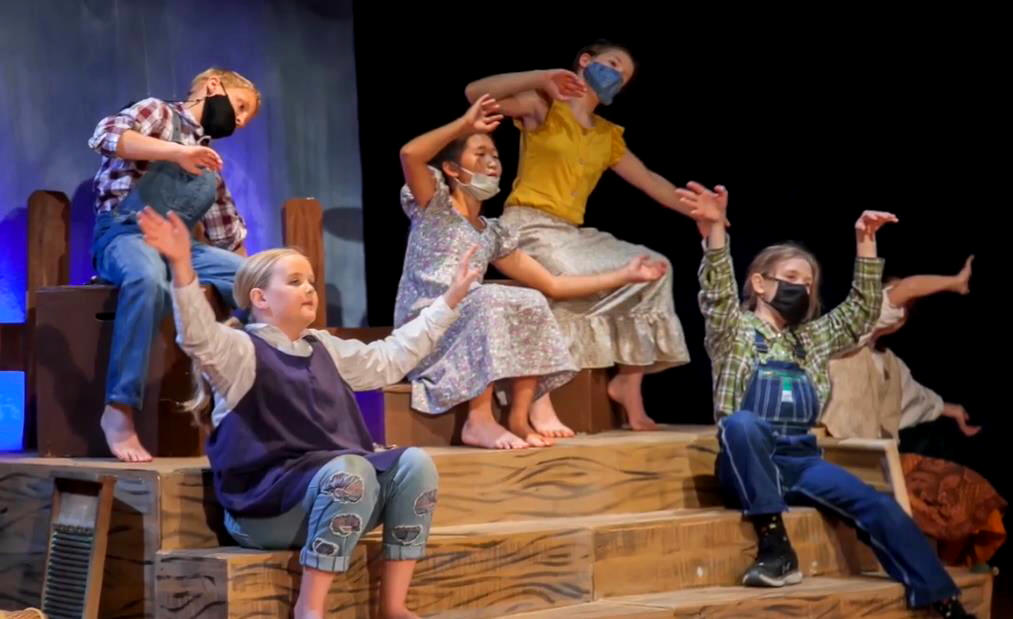 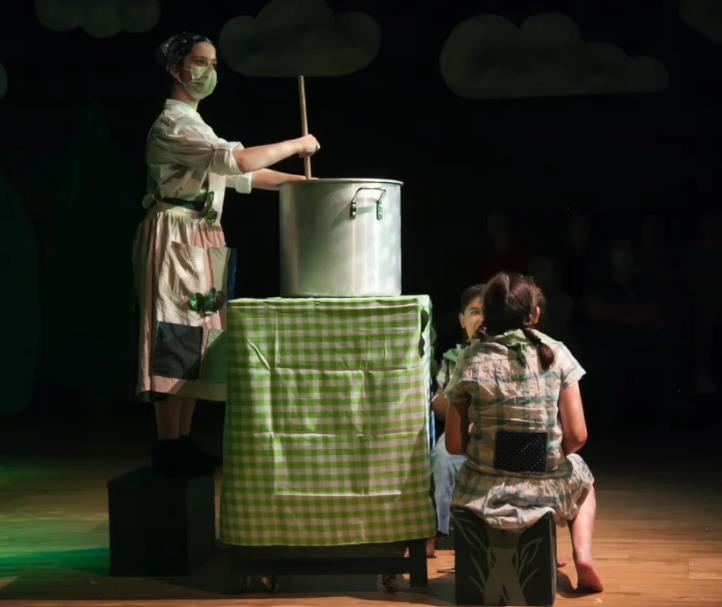
Auburn Area Community Theatre,
AL performs ArtReach's Jack
and the Beanstalk
Sassafras:
A sassafras tree has aromatic leaves and bark; it is
often used to make tea. The word is often used to describe someone
who is “sassy”.
Holler:
This word is slang for “hollow”, used in Appalachia to
describe a small rising valley region between two hills or mountains.
In this play Jack lives in Sweetwater Holler and is nicknamed
“Sweetwater Jack”.
Fee
Fie Foe Fum: Nonsense syllables which appear in an
old-time fairy tale Jack and the Beanstalk. These nonsense words are
changed throughout the play to create humorous rhymes.
"Jack
lives in Sweetwater Holler and is called Sweetwater Jack."
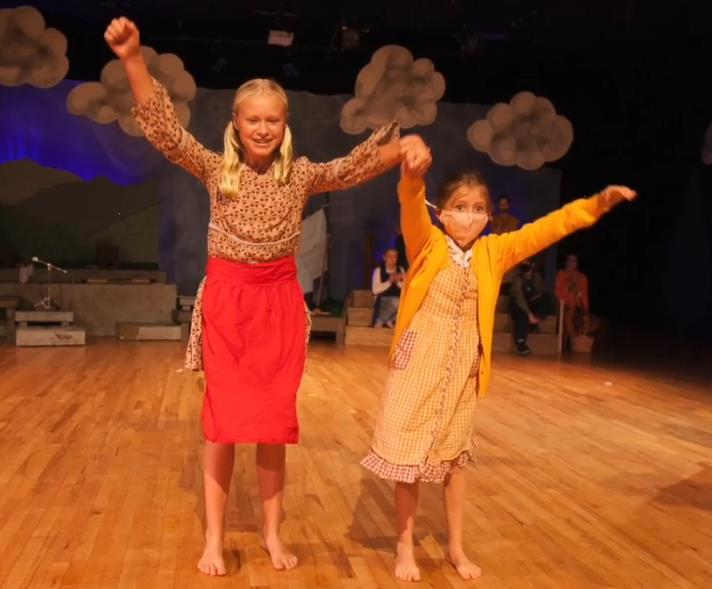 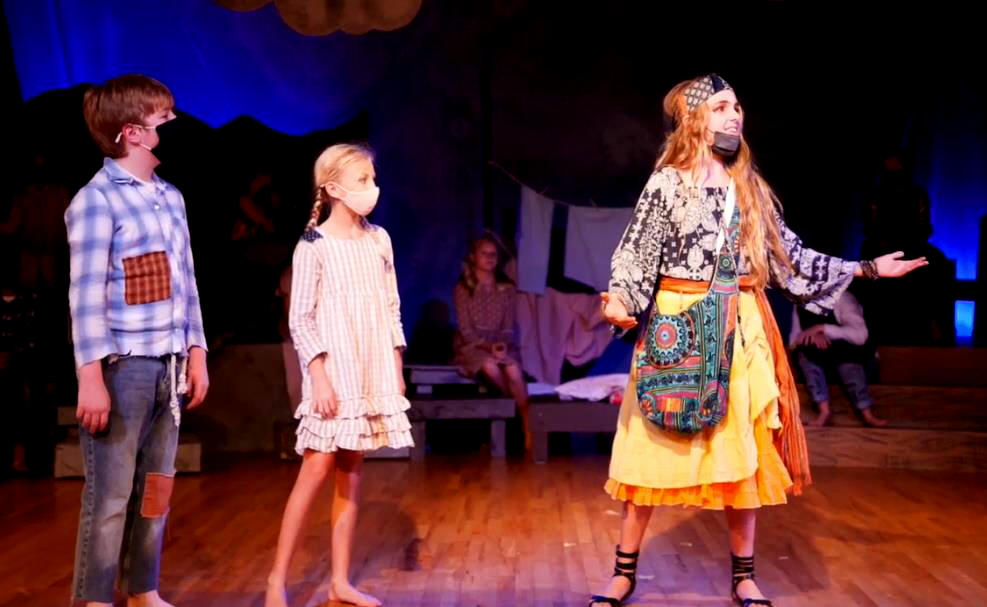
Auburn Area Community Theatre,
AL performs ArtReach's Jack
and the Beanstalk
Flapjacks:
A thick, sweet cake made of oatmeal usually with molasses or honey.
The words sometimes describes pancakes.
Fairy
Fay: Fay is a form of the word “Fairy”.
Fairy is an airy mythical being with a kind disposition. So the term
“fairy fay” in Polly Wolly Doodle probably is a kind endearment.
Crescendo:
A gradual increase in the loudness of a sound or section of music. In
this play the audience and players are asked to build their sounds
and movements to a “crescendo” so that when the beanstalk
is grown it will be exciting as possible.
"Hop
Along Cassidy, a name for a cowboy hero of wild west fiction."
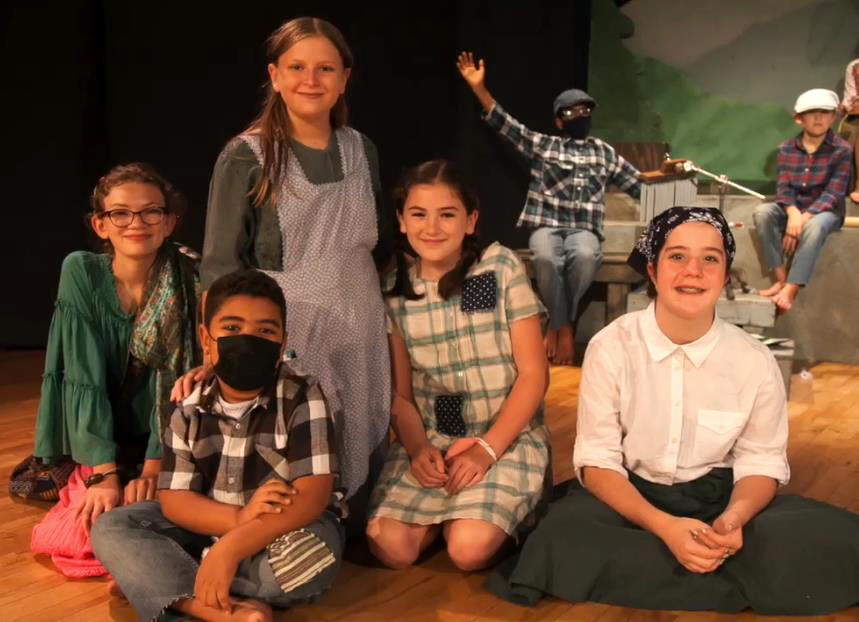 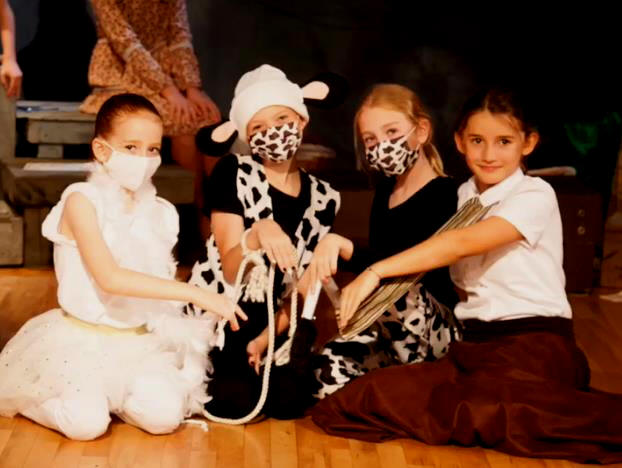
Auburn Area Community Theatre,
AL performs ArtReach's Jack
and the Beanstalk
Strum
Along Cassidy: This character’s name is a play on
the name of Hop Along Cassidy, a name for a cowboy hero of wild west fiction.
East
Pointe Drama Holds Poster Contest, ArtReach's
The Little Mermaid
Greenwood Life, AR
Easy for you,
creative fun for them!
Take a cue from
East Pointe Drama Club!
Partner up with art class and have kids create posters for their
upcoming ArtReach play performance. Display all of them in the
school halls for a week before the performance to create
excitement. Have the kids or teachers take a vote and present
the award at the end of the performance. East Point Drama Club
had a great time with their contest:
East Pointe Drama Club held
their annual poster contest for the upcoming performance of "The
Little Mermaid." Look for posters at ARVEST Bank.
Have
a Drama
Poster Contest!
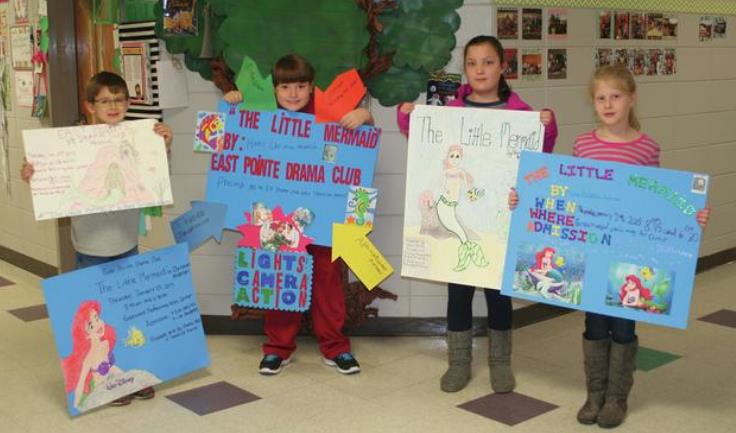
(L to R): 1st grade winner,
Jadyn Townley, not pictured; 4th grade winner, William Gaines; 3rd
grade winner, Mason Williams; 5th grade winner, Carolyn Young; and
2nd grade winner, Avery Maxwell.
Consider asking a neighborhood
business such as a bank or market
to display the posters for a month after the performance!
STUDENT
SHOWCASE: 1000 PAPER CRANES
Academy at the
Lakes, Land O' Lakes, FL
One 6×6 inch piece of
paper plus 20 intricate folds equals one origami paper crane. In
Japanese legends, cranes are powerful creatures that are respected
for their ability to bring luck and grant wishes. The legend states
that when one thousand cranes are created, the crane will grant a
wish or eternal luck. Art students in grades 5-12 worked for two
weeks to create one thousand paper cranes. Afterward, the students
combined the cranes into garlands. Finally, the installation art
piece was complete and ready for its theatrical debut.
Art
students in grades 5-12 worked for two weeks.
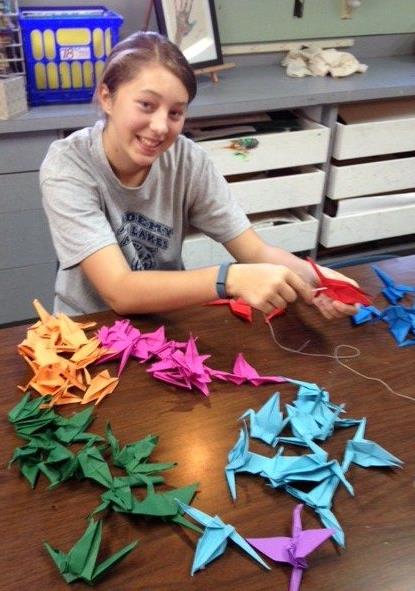 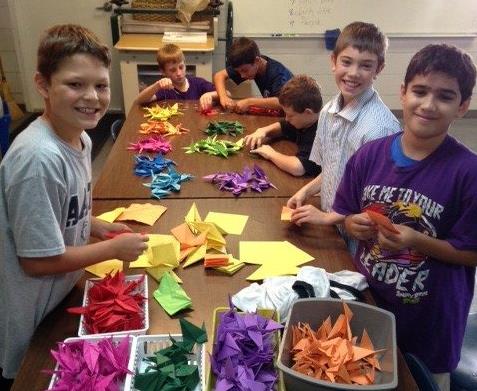 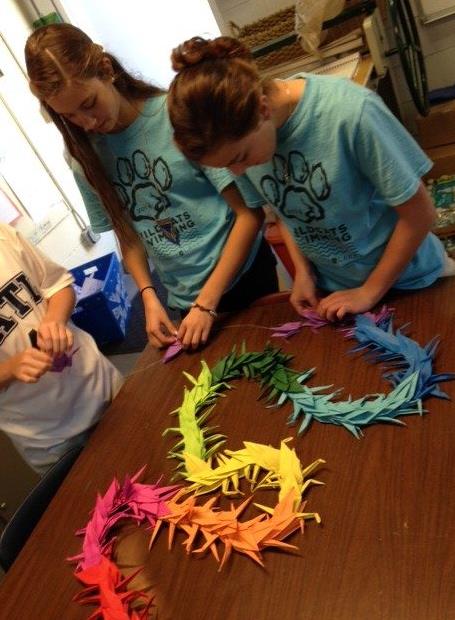
ArtReach's A
Thousand Cranes at Academy
at the Lakes, Land O' Lakes, FL
In collaborative fashion, the
Middle Division joined hands with the Upper Division to make a unique
drama class this fall. Together they rehearsed and staged "A
Thousand Cranes" by Kathryn Schultz Miller. A true story of
peace arising from the aftermath of the atomic bomb in Hiroshima, the
story still rings true today. The crane is a symbol of peace in
Japan, so Sadako Sasaki, the protagonist, decides that if she makes a
thousand cranes, she will survive her bout with leukemia and live;
however, her wish does not come true. Even ten years after the
bombing, children and adults still felt the effects of the atomic
explosion. Now a statue stands in Hiroshima celebrating her life. In
studying and preparing for the play, Academy actors learned about
Sadako, her real life, and the historical events and effects of the
bombing. In addition they learned about Kabuki theatre, the national
theatre of Japan. Drama students performed the play for grades 7-8 on
October 29 and 30 during Advisory.
Each year, students from all
over the world make groups of one thousand paper cranes and send them
to the Children's Peace Monument in the Hiroshima Peace Park in
Japan. The installation piece created by Academy students will be
displayed here on campus. The piece stands as a reminder of the
importance of world peace and the individual role each of us plays in
creating a peaceful world.
Heroes
Are Made of This: Studying the Characters of Heroes
Language
Arts/Social Studies Classroom Activity for A
Thousand Cranes
First Stages
Theatre, Milwaukee
(This activity is in the
online A Thousand Cranes
study guide: https://www.firststage.org/media/pdf/CRANES_EG.pdf
Taken directly from: https://www.readwritethink.org/lessons/lesson_view.asp?id=784)
1. Divide the class into small
groups, and ask them to list as many heroic and un-heroic traits as
they can.
2. After allowing students
ample time to brainstorm in their groups, ask each group to share
their ideas.
a. As students list their
traits, write them on the board, chart paper, or an overhead
transparency so that you have a class list of traits. Ask students to
copy the traits down for later use.
b. Ask the class to infer any
heroic traits based upon un-heroic traits or vice versa.
A
Powerful Story About a Real Hero
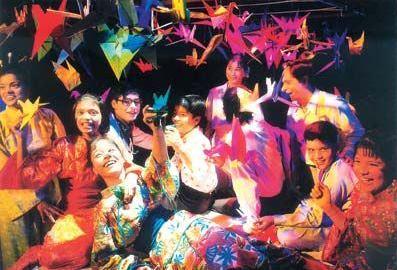 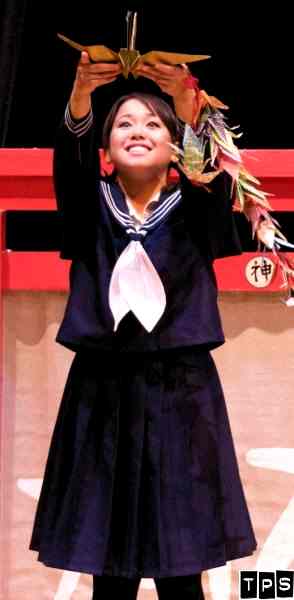
The National
School of Drama, Delhi, India - First Stage Milwaukee
For A Medium
Size (Medium) Cast of Teens, Middle Schools, High Schools
3. Next, ask the class to
discuss why these various traits listed are classified as heroic or un-heroic.
a. Make a point of identifying
which traits the class agrees on and which there is some question
about. It is fine if there is disagreement. The point with this
exercise is not to create consensus but to explore the idea of
heroism, which is a culturally constructed concept.
4. Ask students to name
heroes-historical, contemporary, or fictional. List the names
students share on the board, an over head, or chart paper.
5. Ask students to name some
villains-historical, contemporary, or fictional. Again, list the
names students share on the board, an overhead, or chart paper.
6. Once you have a good list,
ask the class to discuss the individuals on the board, using the
following questions to guide the conversation:
a. Do we agree on who is or
isn't a hero?
b. When we disagree about
whether someone is a hero, what are we considering? Why do we disagree?
c. What makes the heroes, heroes?
d. And what makes the
villains, villains?
7. After the discussion, make
any adjustments or revisions to the class list of heroic and
un-heroic traits.
8. Ask students to return to
their small groups and arrange the heroes whose names they gathered
at the beginning of the session into categories other than
historical, contemporary, and fictional.
"What
makes heroes, heroes?"
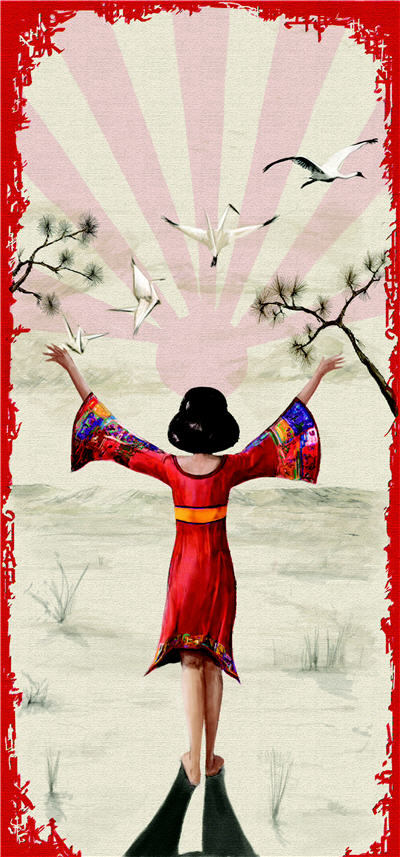 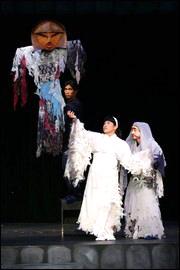
Pima Community College, AZ
- Honolulu Theatre for Youth
9. Come back together as a
class, and ask each group to explain what categories they created and
who they listed in each.
a. Ideally, as this discussion
progresses, students may begin to speculate that heroes and heroism
are not fixed terms.
10. After reading the story of
Sadako, or seeing the production of A
Thousand Cranes, have students discuss how Sadako can be viewed
as a hero.
a. What heroic traits that
were listed previously does Sadako possess?
b. Who are other heroes
mentioned earlier that share similar traits and qualities with Sadako?
Creative
Ideas for ArtReach's
Beauty and the Beast Activities
Beauty and the
Beast: Exercises & Activities
Discussion:
Before the Play:
Talk about
theatre and what a play is. What other plays have you
seen? Describe them to the class. Why do you think
certain parts of those plays are memorable to you? What do you
expect this play will be like? What is the difference between
seeing a play on television or movies and seeing actors perform it live?
Discuss you
students the proper etiquette for audience members during a live
performance. Impress upon them that the actors they see are
live people who care very much how you respond to the work they are
doing. Young audience members should learn the meaning of
applause and laughter and that they should be polite to the people
who are performing for them.
Read the
original story and the synopsis of the play that appear in this
Teachers Guide. How are the stories alike? How are they
different? Talk about the practical consideration of putting on
a play and why the actors might need to adjust the story in order to
present it on stage.
The play takes
place in France where they used to tell fairy tales. Look up France
on the Internet and in books, locate it on the globe. Talk
about what we know about the country, history, music and the
people. What kinds of clothes do they wear and what did the
wear in years past? Remember your answers when you see the
actors in their costumes. Or if you are performing in the play
use the pictures you find to help create your costume.
"Children
will participate by helping make sounds etc."
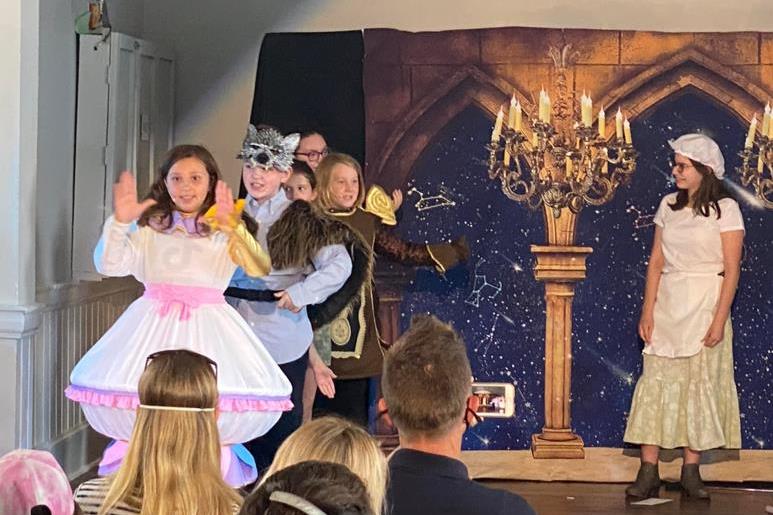 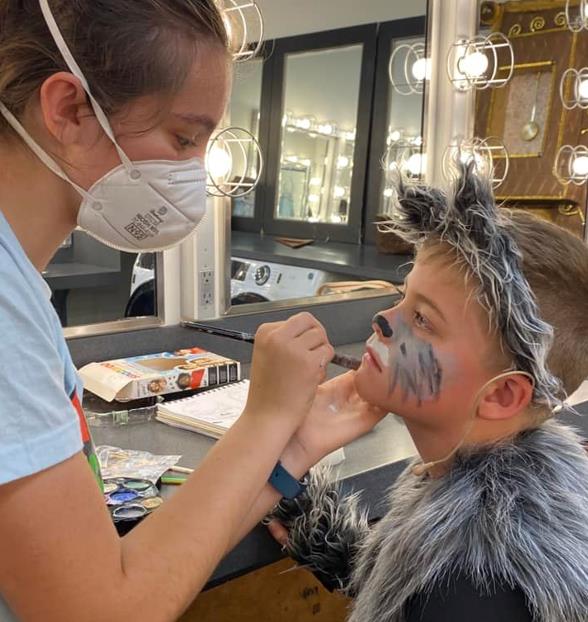
ArtReach's
Beauty and the Beast - Theatre in the Park, Severna Park MD
During the
play, children will be asked to participate by helping make sounds,
wind, music, wolves, etc.. Describe a storm, scary forest,
angry mob or ferocias wolves and talk about how they sound and
move. Point out the actual events or other plays or movies you
may have seen. How does your play relate to events in "real
life” or other "fantasies”?
Talk about
clothes and what they say about your personality. Name some of
your favorite movie stars or musicians and how the clothes they wear
shape the image we have of them. What makes some clothes come
into fashion why others go out of style. Describe your favorite
shoes, hat and coat. What makes you like them? How do you
feel when you wear them?
Discussion:
After the Play:
Discuss in more
detail the play you have just seen. Who is your favorite
character and why? Talk about how the actors created the
illusion of many things such as the castle, the forest, the
marketplace and the invisible painting that Marcel sets up.
Talk about how you were asked to use your imagination as opposed to
movies and cartoons that show you a picture of everything.
Talk about some
of the characters you saw in the play such as the Villagers and
Household Servants. What did they do with their voices and
bodies to convey their character to you? Would you like to try
your hand at acting? Write down the names of characters such as
Beast and Wolves. Come up with crazy names as Huey Kazooie and
show the class how Huey would act and talk. Choose other
characters, perform them and ask your classmates to guess who you are.
Charles
Perrault wrote many play besides Beauty and the Beast.
What titles are you familiar with? Can you recount these
stories? Which do you like best and why?
What do you
think a magical Prince-turned-Beast would actually look like?
Draw a picture of the Beast showing how he thought he looked once
like a Prince. Draw a picture of the Prince before he turned
into a Beast.
What is the
meaning of this famous story? When people say "his bark is
worst than his bite” what do you think they mean? The
Prince embarrassed when he realized he had been tricked and turned
into the Beast. What might he have done to prevent this embarrassment?
"Would
you like to try your hand at acting?"
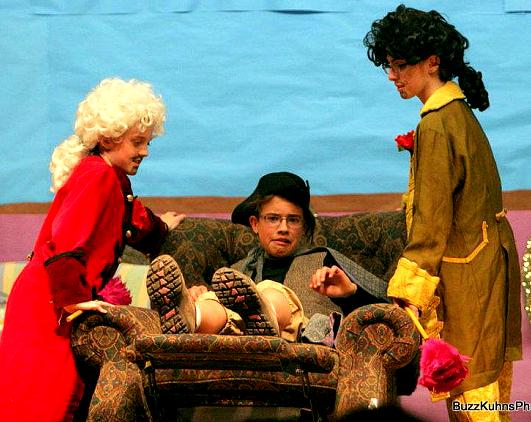 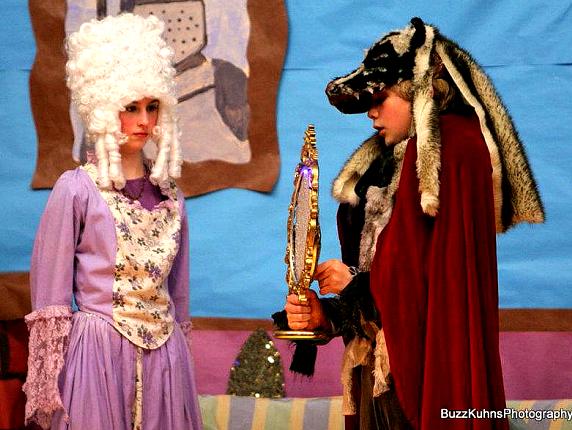
ArtReach's
Beauty and the Beast - Monkton
Central School, Bristol, VT
Classroom
Activities:
CLASS
STORY: Read a version of the story as a class.
View an animated version and compare the two. After seeing the
show, compare all three genres.
BEING
A HERO: Ask the class what it means to be a hero.
Brainstorm a list of qualities that make a person seem like a
hero. In groups, pick the most important qualities and identify
heroes today. Share as a class. Discuss whether or not there is
a hero in Beauty and the Beast.
JOURNAL
ACTIVITY: Have students imagine that they are in
Beauty’s shoes. In order to save their fathers, the
students have to live with a terrifying beast. What would it feel
like? Would the students have the courage to do it?
"YOU
ARE A HERO!”: Ask students to write about a time
in their lives when they had to overcome something or helped someone.
FROM
THE OUTSIDE IN: Have students imagine that they could
only show people their worst qualities. No one would ever know
the good qualities they had deep down inside. What would that
look like? What would it feel like? Have students draw
what that person would look like, and write a story to go along with it.
FRACTURED
AND FUNNY: Have students write a fractured version of Beauty
and the Beast. Explain that a fractured fairy tale is made to be
humorous by changing the story in a surprising way; like changing a
character or adding today’s language and events to the
story. Encourage the students to take creative risks.
NOW
YOU SEE IT, NOW YOU DON’T: The element of magic is
common in fairytales. In Beauty and the Beast, things
aren’t always what they seem. Explore optical
illusions. Look at examples as a class. View optical
illusions as a class using the internet and books.
"Activity:
Rewrite the ending of Beauty and the Beast."
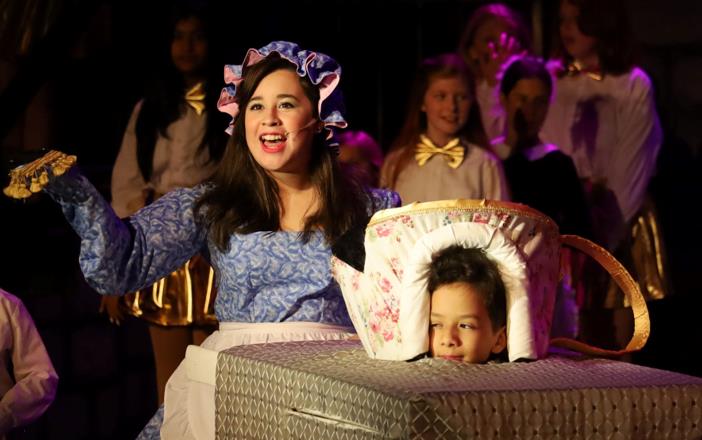 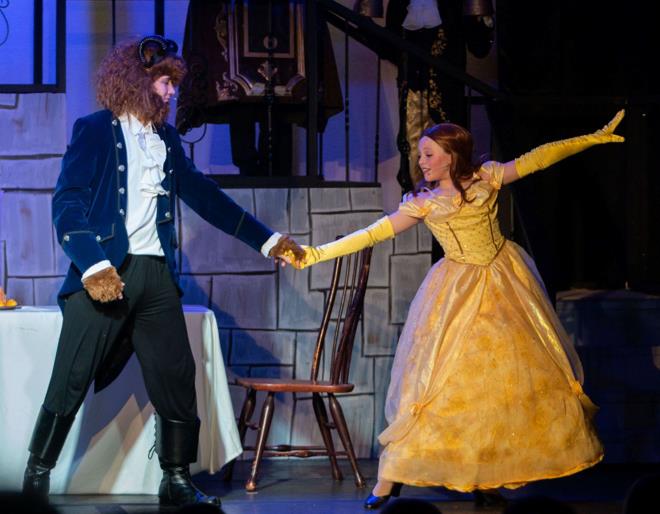
ArtReach's
Beauty and the Beast - North Texas Performing Arts, Plano TX
AROUND
THE WORLD ONCE UPON A TIME: Research different fairy tales
from around the world and different times.
HANDING
INFORMATION DOWN GENERATION TO GENERATION: Gather students on
the rug and have them sit in a circle. Explain that fairytales
were handed down through word of mouth. Pretend that each
student sitting in that circle is another generation. Play a
game of "telephone” (one person thinks of a sentence and
whispers it in the person sitting next to him/her’s ear, and
that person passes, and so on) to demonstrate how stories change.
RE-WRITE
HISTORY: Ask students to rewrite the ending of Beauty
and the Beast. What would the play version of this look
like? After rewriting the way the story turns out, have
students design a scene from their versions (the castle, forest,
etc&ldots;) using only their imaginations to guide them.
FINISH
THE PICTURE: Have students design what the costumes
would look like. Remind them that the story can take place
anywhere and in any time period.
ArtReach's
The Legend of
Sleepy Hollow is Creative Fun for Students
Classroom
Discussions and Activities from
Teachers Guide
BEFORE THE PLAY:
1. Read the outline of the
play and the glossary that appears in this Teacher's Guide. Advanced
students should read the original story by Washington Irving. When he
wrote this story it was one in a whole book of stories called The
Sketch Book. Rip Van Winkle is another famous story in the book. Can
you tell the story of Rip Van Winkle?
2. Washington Irving is called
"the father of American literature". Why do you think they
called him that? Washington Irving was born when George Washington
was president and was named in honor of him. How long ago was that?
Does that seem like a long time to you? Actually, it is a very short
time for a nation to exist. American is still a young country. Before
The Legend of Sleepy Hollow was written there had been few American
writers who were considered to be very good, so Americans were very
proud of him.
3. How do you know if a writer
has written something good? Consider some of he rich phrases in
Irving's writing:
"Katrina was&ldots; plump
as a partridge, ripe and melting and rosycheeked as one of her
father's peaches."
"Ichabod's head was
small, flat at top, with huge ears, large green glassy eyes and long
snipe nose."
Can you see how Irving helps
us to imagine his story vividly because of his talent for writing?
4. What do you like to do in
autumn? Carve a jack-o-lantern, drink apple cider, gather pretty
leaves? Talk about autumn and how that season affects us. Do you know
any scary stories? Sit in a circle as if around a fired and tell each
other ghost stories that you know.
Washington
Irving: The Father of American Literature
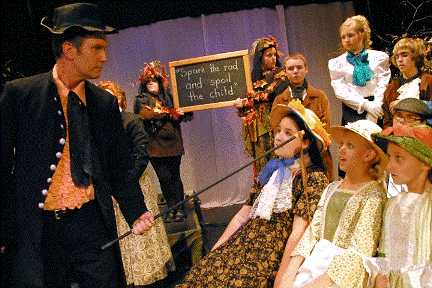 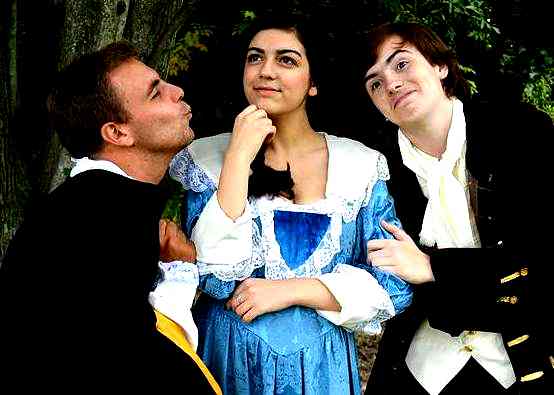
ArtReach's
The Legend of Sleepy Hollow
- Gaffney Little Theatre, SC - DCP Theatre, Telford, PA
AFTER THE PLAY:
1. Talk about the play you
have seen. Was it how you imagined the story when you read it? What
things are different and which are the same? Have you seen the Walt
Disney movie version? How were the two versions different? Why did we
laugh at Ichabod? Did you want Katrina to marry Brom bones or Ichabod?
2. Consider all the food that
is described in the play. What kind of food do you like to eat in
autumn - pumpkin pie, caramel apples, apple strudel? Bring your
favorite recipes (ask you parents to help you) and share with the
class. If you give each other copies you will soon a book full of
autumn treats!
"Share
your experiences with your classmates."
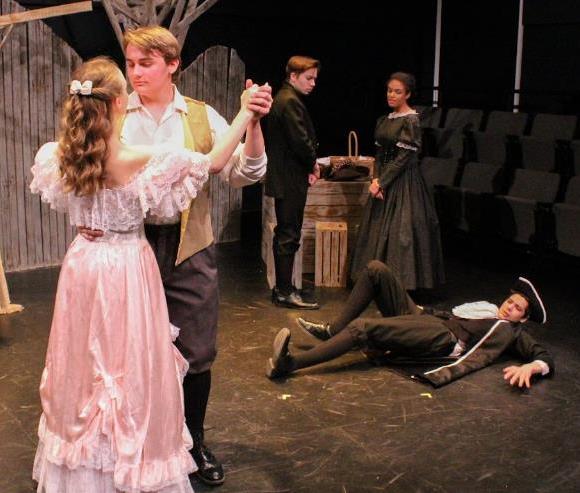 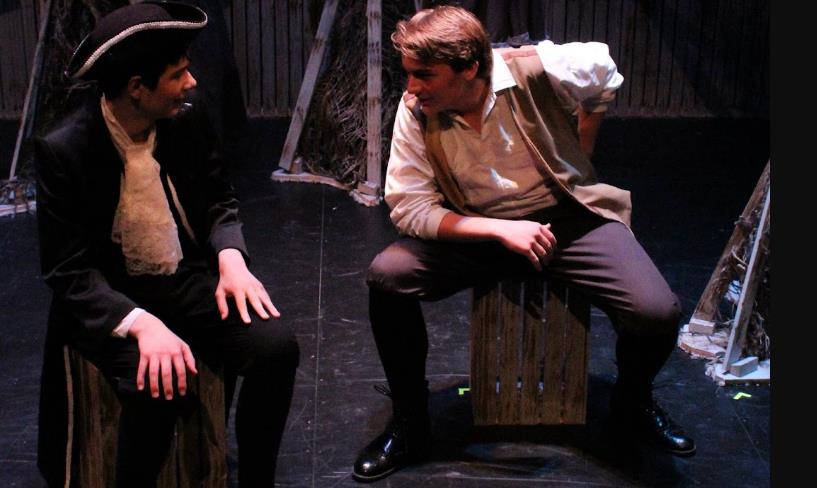
ArtReach's
The Legend of Sleepy Hollow - Winthrop High School Drama,
Winthrop MA
3. The people of Sleepy
Hollow, Dutch settlers who came from Holland to live in America,
are much like the pilgrims we think of at Thanksgiving. Many people
came to American 200-300 years ago. They came here to pursue a better
way of life than they had in Europe. Are you descended from early
American settlers? Talk about other immigrants to the United States
and discuss the issue of immigration in American history.
4. Did you laugh because
Ichabod was scared of the Headless Horseman? Why was that funny?
5. Have you ever been scared
of something that turned out to be harmless/ have you seen movie that
scare you? Share your experiences with your classmates.
6. What things (movies, books,
darkness etc.) scare you? Tell us what you do when you're scared. Can
you help each other figure out how not to be afraid of things that
really aren't there.
ArtReach's
The Emperor's
New Clothes
Classroom
Exercises and Activities - General Preparation and Discussion
Before
the Play:
1. Talk about theatre and what
a play is. What other plays have you seen? Describe them to the
class. Why do you think certain parts of those plays are memorable to
you? What do you expect this play will be like? What is the
difference between seeing a play on television or movies and seeing
actors perform it live?
2. Discuss you students the
proper etiquette for audience members during a live performance.
Impress upon them that the actors they see are live people who care
very much how you respond to the work they are doing. Young audience
members should learn the meaning of applause and laughter and that
they should be polite to the people who are performing for them.
3. Read the Hans Christian
Andersen's story and the Outline of the Play that appear in this
Teachers Guide. How are the stories alike? How are they different?
Talk about the practical consideration of putting on a play and why
the actors might need to adjust the story in order to present it on stage.
4. The play takes place in
Russia where they used to have Emperors rule the country. Look up
Russia on the Internet and in books, locate it on the globe. Talk
about what we know about Russia. What kinds of clothes do they wear
and what did the wear in years past? Remember your answers when you
see the actors in their costumes. Or if you are performing in the
play use the pictures you find to help create your costume.
"Kids
participate by helping Peter the tailor."
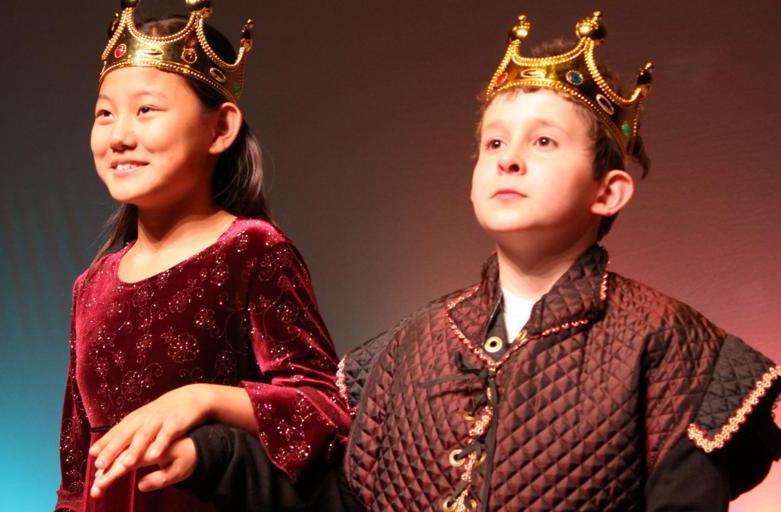
ArtReach's
Emperor's New Clothes - Greenbrier Valley Theatre WV
5. During the play, children
will be asked to participate by helping Peter to make the sounds of
the looms at work. Describe a loom or show a picture of one and talk
about how they work. Explain that the cloth is woven from textile
fibers. Point out the clothing of class members and show how
different colors of thread make patterns. In the play Peter weaves
threads made of gold!
6. Talk about clothes and what
they say about your personality. Name some of your favorite movie
stars or musicians and how the clothes they wear shape the image we
have of them. What makes some clothes come into fashion why others go
out of style. Describe your favorite shoes, hat and coat. What makes
you like them? How do you feel when you wear them?
After
the Play:
1. Discuss in more detail the
play you have just seen. Who is your favorite character and why? Talk
about how the actors created the illusion of many things such as the
palace, the marketplace and the mirror the Emperor looked into.
Talk about how you were asked to sue you imagination as opposed to
movies and cartoons that show you a picture of everything.
2. Talk about some of the
characters you saw in the play such as the blacksmith and the horse,
the cabinet ministers and the Empress. What did they do with their
voices and bodies to convey their character to you? Would you like to
try your hand at acting? Write down the names of characters such as
elephant and antelope. Come up with crazy names as Huey Kazooie and
show the class how Huey would act and talk. Choose other characters,
perform them and ask your classmates to guess who you are.
3. Hans Christian Andersen
wrote many play besides Emperor's New Clothes. What titles are you
familiar with? Can you recount these stories? Which do you like best
and why?
4. What do you think magical
clothes would look like? Draw a picture of the Emperor showing how he
thought he looked in his "magic clothes". Draw a picture of
the magic clothes you would like to wear.
5. What is the meaning of this
famous story? When people say "the Emperor has no clothes"
what do you think they mean? The Emperor was embarrassed when he
realized he had been tricked. What might he have done to prevent this embarrassment?
ArtReach's
Amelia Earhart Sparks Learning!
Study Guide
Materials for Fun
School Activities
AMELIA'S
IMPACT AND LEGACY: Amelia Earhart was a trailblazer not only
in the field of aviation but also in the fight for women's equality.
All of Earhart's successes came during a time of American history
where many thought that a woman's place was in the home. She is
quoted as saying, "women must try to do things as men have
tried. When they fail, their failure must be but a challenge to
others." During her life, Earhart
was extremely vocal about views of equality for men and women in the
workplace, and used her public platform to help advance the fight for
equality. A mlae journalist once asked her, "you're saying that
women are or should be the equal of men in aviation? She replied,
"no, not in aviation. In everything. In 1929 Amelia helped found
the Ninety-Nines, Inc., the first organization for women aviators.
Her views of marriage were also unconventional for her time. When
shemarried George Putnam, she kept her last name and emphasized that
their marriage would be a "partnership" with "dual control."
"Women
must try to do things as men have tried."
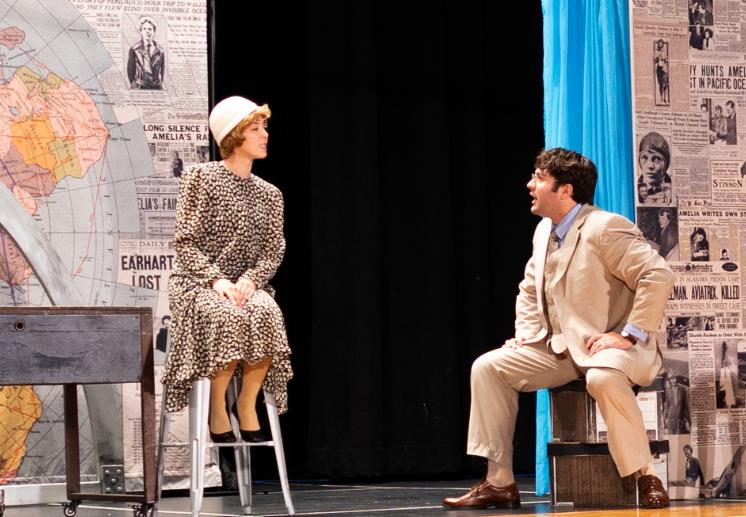 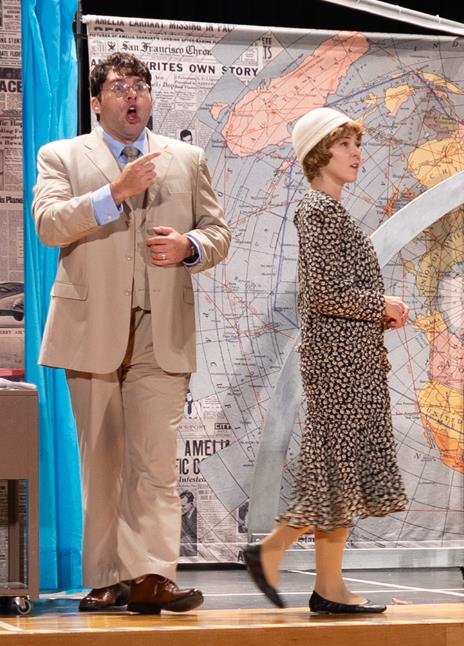
ArtReach's Amelia
Earhart - Scenes from The Rev Theatre Company, Auburn NY
"Everyone
has his own Atlantics to fly. Whatever you want very much to do,
against the opposition of tradition, neighborhood opinion, and
so-called common sense- that is an Atlantic."
LADY
LINDY: Amelia Earhart was given the nickname Lady Lindy by
George Putnam because of her uncanny resemblance to Charles Lindberg,
who completed the first solo transatlantic flight in 1927. Being one
of the top promoters in the 1930's, He knew that the press would love
to use that catchy nickname, and he was right. After the success of
the Friendship flight, the papers had front page headlines that read
"Lady Lindy- First Woman To Cross The Atlantic!" Amelia
never embraced this nickname
- she preferred that her friends simply call her AE.
"Lady
Lindy- First Woman To Cross The Atlantic!"
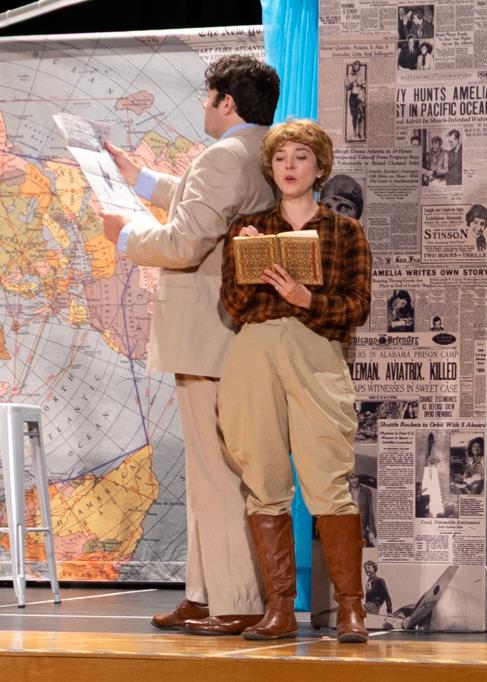 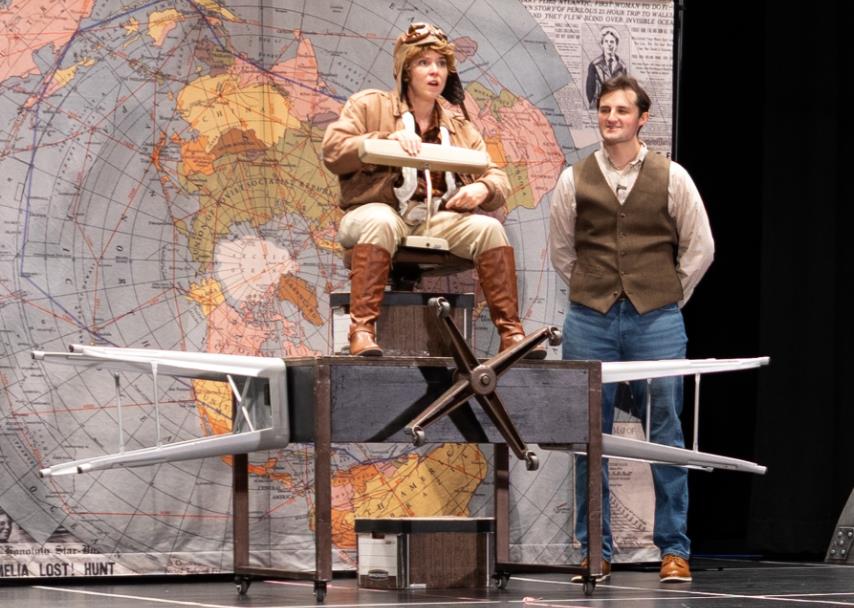
ArtReach's Amelia
Earhart - Scenes from The Rev Theatre Company, Auburn NY
Dear
Amelia: Amelia received lots of fan mail from children who
wanted to know about flying, or from those that admired her bravery
and perseverance. Write a letter to Amelia and ask her one question
that you wish she could answer.
The
Joy of Flying: Amelia often described the pure joy of flying.
What in your life brings you pure happiness? Write or draw a picture
describing what it is and share it with your classmates.
We
Can All Be Pioneers: Amelia Earhart was a pioneer in the
field of aviation, but also in the fight for Women's Equality.
You can also be a Pioneer! To be a Pioneer, you need to give it your
all and try to be the best at it. Don't be afraid to try new things,
even if no one has done it or if it seems too difficult. Once you
have your sights set on something, don't let anyone stop you or tell
you that you can't do it.
With these things in mind, think about something in your own life
that you are passionate about achieving, and write down three action
steps that you could do today to start making that dream a reality.
"You
can also be a Pioneer!"
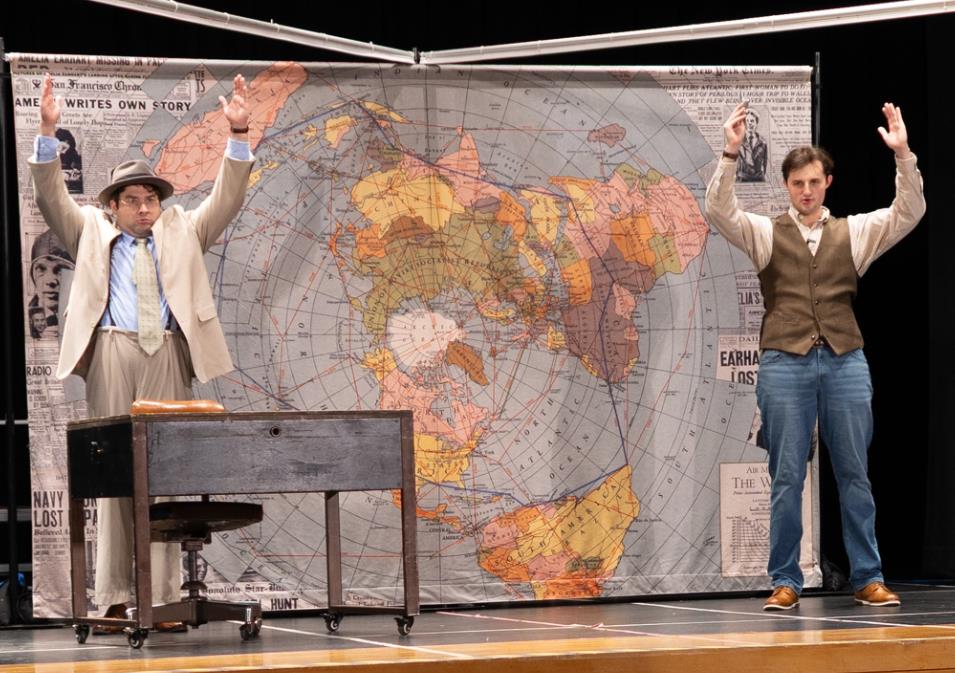 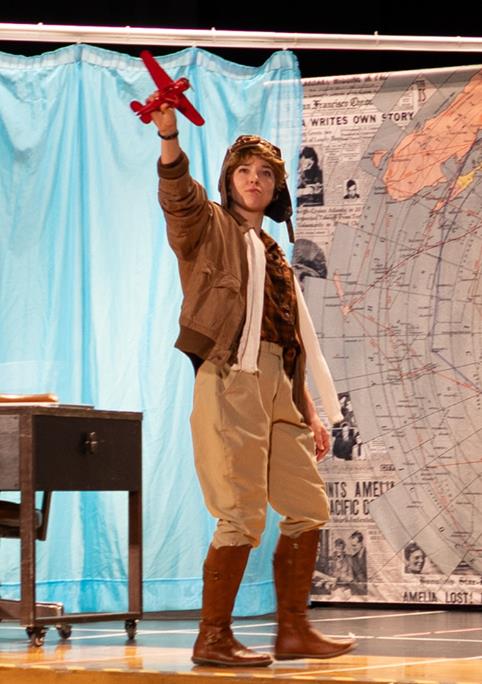
ArtReach's Amelia
Earhart - Scenes from The Rev Theatre Company, Auburn NY
Make
Your Own Compass: In the early days of flying, planes did not
have all of the tools that modern-day planes had. In the beginning,
many pilots only had compasses to help them know which direction
they were going. You can make your own at-home compass in just a few
easy steps! MATERIALS: Bowl, water, plastic bottle cap,
paperclip, magnet INSTRUCTIONS: Fill the bowl with water. Take
your paperclip and straighten it out and then using your magnet,
apply light pressure to the paperclip and run it across the paperclip
in a single direction about 3 to 4 times, making sure to pull the
magnet away from the paperclip when returning to the start point.
Then place the bottle cap into the bowl so that it floats and put the
paperclip on the bottle cap. The paperclip should then start to spin
and point north!
*Source: Glazer
Children's Museum- https://glazermuseum.org/compass
Classroom
Activities Page 7: <
Prev | 1
| 2
| 3
| 4
| 5
| 6
| 7
| 8
| 9
| Next >
All
Free Resources
|